Bitumen & Asphalt
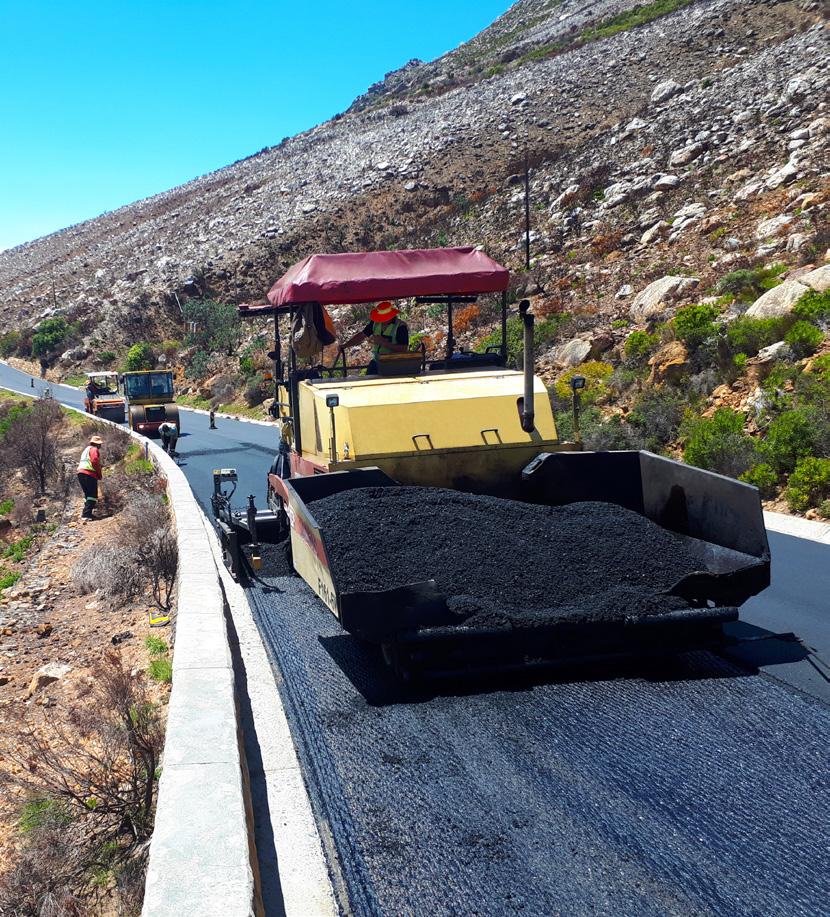
Precast reservoir construction Water & Wastewater IMESA The official magazine of the Institute of Municipal Engineering of Southern Africa www. infrastructurenews.co.za INFRASTRUCTURE DEVELOPMENT • SERVICE DELIVERY • ROADS • BUILDING • MAINTENANCE • ENERGY ISSN 0257 1978 Volume 47 No. 08 • August 2022 • R55.00 (incl. VAT) AECI MUCH
for sustainable asphalt BIM Technology Optimising BIM investments
ASPHALT Solutions
Why pipe jacking is a niche profession Geotechnical
First road-legal CounterMix plant for Southern Africa


The process of Molecular orientation, which greatly enhances the PVC’s physical and mechanical properties, has made the TOM500® PVC-O the most stateof-the-art pipe around. TOM500® PVC-O is unbeatable and you will not find anything else out there that is stronger or more resistant. You can take our word for it!

THE
TOM500 PVC-O
MOST
ON THE MARKET! -STRONGwww.sizabantu.com | proudly@sizabantu.com
ADVANCED PIPES







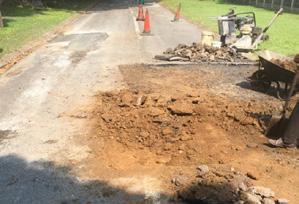
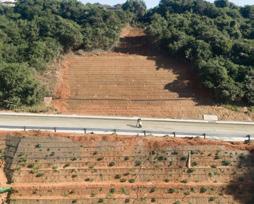

INSIDE VOLUME 47 NO. 08 AUGUST 2022 Precast reservoir construction Water & Wastewater IMESA The official magazine of Municipal Engineering www. infrastructurenews.co.za INFRASTRUCTURE DEVELOPMENT SERVICE DELIVERY • ROADS • BUILDING MAINTENANCE • ENERGY ISSN 0257 1978 Volume 47 No. 08 August 2022 • R55.00 (incl. VAT) AECI MUCH ASPHALT Solutions for sustainable asphalt BIM Technology Optimising BIM investments Bitumen & Asphalt First road-legal CounterMix plant for Southern Africa Why pipe jacking is a niche profession Geotechnical ON THE COVER Paving of New Crumb Rubber Technology warm-mix asphalt produced by AECI Much Asphalt on Clarence Drive between Gordon's Bay and Rooi-Els. P6 www.infrastructurenews.co.za Regulars Editor’s comment 3 President’s comment 5 Index to advertisers 56 Cover Story Solutions for sustainable asphalt 6 BIM Technology Getting the best value from BIM investments 10 ISO 19650 in South Africa 12 Water & Wastewater Precast concrete system accelerates reservoir construction 14 Are we driving a car without a fuel gauge? 18 Energy Taking action to bridge South Africa’s power gap 20 Women in Construction Women winning in construction –ERWIC Awards winners announced 22 Roads & Bridges Innovative solutions to African challenges 25 The road to smart mobility 26 Bitumen & Asphalt First road-legal CounterMix plant for Southern Africa 30 SATBinderrr 2022 – Reasons to be there 33 Flexible and adaptive to a changing world 30 An engineered response to pothole repairs 36 Transportation Engineering Public transport models that work 38 Geotechnical The benefits of reinforcing slopes with Green Terramesh 42 Why pipe jacking is a niche profession 44 Buildings Dinosaur-themed brickwork 46 Landfill & Waste Management Investment in mechanisation to boost municipal waste compliance 47 Green interventions for Kampala 48 Vehicles & Equipment All the bells and whistles for new E-series water tankers 50 Compaction innovation on show at bauma 52 Cement & Concrete Rocla and Technicrete recognised at CMA Awards 53 Watertight solutions for new treatment works 55 Economical foamed concrete suitable for limited budgets 56 42 GEOTECHNICAL BITUMEN & ASPHALT 36 30 50 VEHICLES & EQUIPMENT
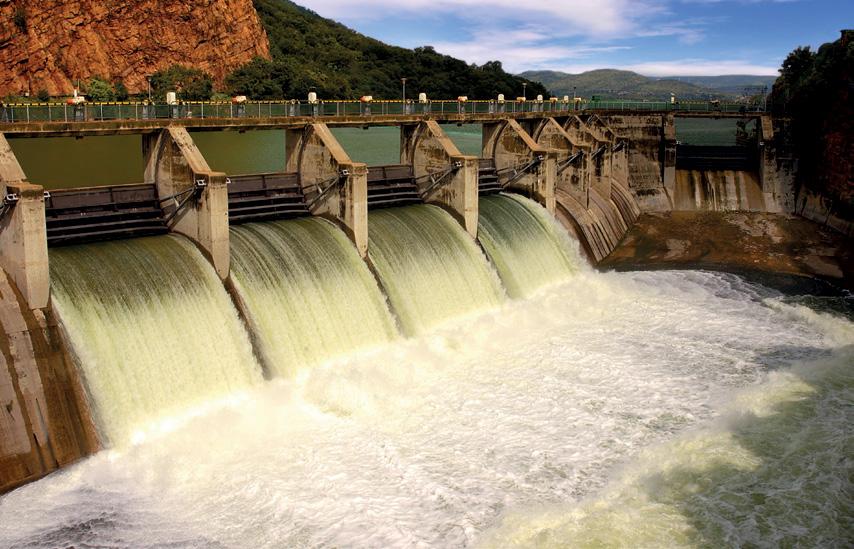
wireless Monitoring
Dam & Basin Water Levels

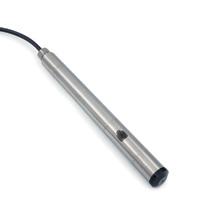
• Digital Water Level and Conductivity Sensors
• Highly Precise 0,02%FS*
• Wired Readout with Standard Process Signals
• Wireless Readout with ARC1 Modem Datalogger by 4G, NB-IoT (Cat M1 / M2) or LoRa
• Compatible with KELLER Kolibri Cloud

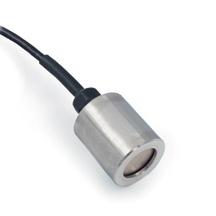
keller-pressure.co.za
Series 36XW Level Series 36XiWCTD Level Conductivity Series 46X Ultra Low Levels 2G 3G 4G
precision at room temperature, accuracy 0,1% FS total error band
*
MANAGING EDITOR Alastair Currie
SENIOR JOURNALIST Kirsten Kelly
JOURNALIST Nombulelo Manyana
EDITORIAL COORDINATOR Ziyanda Majodina
HEAD OF DESIGN Beren Bauermeister
DESIGNER Lizette Jonker
CHIEF SUB-EDITOR Tristan Snijders
CONTRIBUTORS Tian de Jager, Willie de Jager, Vernita Govender, Kobus Kotze, Thivaska Padayachee, Roger Parsons, Bhavna Soni, Astrid van der Laan
PRODUCTION & CLIENT LIAISON MANAGER
Antois-Leigh Nepgen
GROUP SALES MANAGER Chilomia Van Wijk
BOOKKEEPER Tonya Hebenton
DISTRIBUTION MANAGER Nomsa Masina
DISTRIBUTION COORDINATOR Asha Pursotham
SUBSCRIPTIONS subs@3smedia.co.za
PRINTERS Novus Print Montague Gardens
ADVERTISING SALES
KEY ACCOUNT MANAGER Joanne Lawrie
Tel: +27 (0)11 233 2600 / +27 (0)82 346 5338
Email: joanne@3smedia.co.za

The need for a renewed FOCUS ON ROADS
Arenewed focus on road and bridge maintenance, and new construction, is one of the most crucial infrastructure investment priorities for the South African government. This initiative is vital for socio-economic development in both the local urban and rural context, together with the key importance of transport conduits for cross-border trade and ensuing worldwide connections via regional port and air hubs.
in facilitating knowledge exchanges between engineers, contractors and municipalities. The second in the series will be held virtually on 5 October and is highly recommended for all industry practitioners in this segment. Collaboration is the foundation for future success.
Road conferences to attend
PUBLISHER Jacques Breytenbach
3S Media
Production Park, 83 Heidelberg Road, City Deep Johannesburg South, 2136
PO Box 92026, Norwood 2117
Tel: +27 (0)11 233 2600
www.3smedia.co.za
ANNUAL SUBSCRIPTION: R600.00 (INCL VAT) ISSN 0257 1978 IMIESA, Inst.MUNIC. ENG. S. AFR.
© Copyright 2022. All rights reserved.
IMESA CONTACTS
HEAD OFFICE:
Manager: Ingrid Botton
P.O. Box 2190, Westville, 3630
Tel: +27 (0)31 266 3263
Email: admin@imesa.org.za
Website: www.imesa.org.za
BORDER
Secretary: Celeste Vosloo
Tel: +27 (0)43 705 2433
Email: celestev@buffalocity.gov.za
EASTERN CAPE
Secretary: Susan Canestra
Tel: +27 (0)41 585 4142 ext. 7
Email: imesaec@imesa.org.za
KWAZULU-NATAL
Secretary: Narisha Sogan
Tel: +27 (0)31 266 3263
Email: imesakzn@imesa.org.za
NORTHERN PROVINCES
Secretary: Ollah Mthembu
Tel: +27 (0)82 823 7104
Email: np@imesa.org.za
SOUTHERN CAPE KAROO
Secretary: Henrietta Olivier
Tel: +27 (0)79 390 7536
Email: imesasck@imesa.org.za
WESTERN CAPE
Secretary: Michelle Ackerman
Tel: +27 (0)21 444 7114
Email: imesawc@imesa.org.za
FREE STATE & NORTHERN CAPE
Secretary: Wilma Van Der Walt
Tel: +27 (0)83 457 4362
Email: imesafsnc@imesa.org.za
All material herein IMIESA is copyright protected and may not be reproduced without the prior written permission of the publisher. The views of the authors do not necessarily reflect those of the Institute of Municipal Engineering of Southern Africa or the publishers.

The national tolled and non-tolled routes managed by Sanral are maintained according to world-class standards. However, the condition of municipal and provincial roads varies from the occasional pothole to situations where a complete failure has occurred, with in situ recycling and reconstruction required.
Routine maintenance versus temporary repairs
As experts point out, key reasons for these failures include a lack of routine maintenance, compounded by the fact that many roads across South Africa are nearing the end of their serviceable life. In this edition, Johan Hattingh from PHB Consulting Engineers talks about the occurrence of potholes, as well as their causes, with a major emphasis on determining the right repair interventions. Without a detailed engineering insight, combined with expert experience, potholes simply become temporary patch repairs and in certain instances accelerate the deterioration of the surround pavement.
The upside is that routine maintenance lends itself to labour-intensive construction, skills transfer and SMME development. However, the extent to which programmes can be executed effectively depends on up-to-date condition assessment surveys, training and the availability of suitably qualified technical personnel within municipal and provincial roads departments.
Industry initiatives
Initiatives like Sabita’s first Roads Maintenance Forum, launched in April 2022, are invaluable
Upcoming local conferences like SATBinderrr 2022 (21 to 22 September) and the 7th Regional Conference for Africa (18 to 20 October) provide opportunities for more in-depth public and private sector engagement, while serving as a platform for showcasing South Africa’s best-in-class expertise to the world.
Project pipeline
At present, there is a shortage of work available within the roads sector, despite an obvious need. That made the headlines recently when five Sanral tenders amounting to some R17 billion were unexpectedly put on hold.
The Development Bank of Southern Africa (DBSA) was subsequently appointed “to act as the infrastructure procurement and delivery management support agency” to help get these projects back on track. DBSA’s scope includes the evaluation of compliance, plus independent construction management oversight once the tenders have been awarded. Hopefully, a fresh pipeline of Sanral work will start flowing through towards the end of 2022 and into 2023.
In the meantime, municipalities with urgent road maintenance requirements, available budgets, but limited internal capacity, should reach out to private sector investors and construction industry practitioners for the best advice and solutions.





IMIESA August 2022 3 Alastair EDITOR’S COMMENT To our avid readers, check out what we are talking about on our website, Facebook page or follow us on Twitter and have your say.
opportunity In each issue, IMIESA offers advertisers the opportunity to get to the front of the line by placing a company, product or service on the front cover of the journal. Buying this position will afford the advertiser the cover story and maximum exposure. For more information on cover bookings, contact Joanne Lawrie on +27 (0)82 346 5338. Infrastructure News @infrastructure4 construction Water & Wastewater S IMESA infrastructurenews.co.za AECI MUCH ASPHALT Solutions for sustainable asphalt BIM Technology Optimising BIM Bitumen & Asphalt First road-legal CounterMix plant for Southern Africa Why pipe jacking is a niche profession Geotechnical The ABC logo is a valued stamp of measurement and trust. IMIESA is ABC audited and certified.
Cover
a Level 2 BBBEE Contributor: novus.holdings/sustainability/transformation
Novus Holdings is
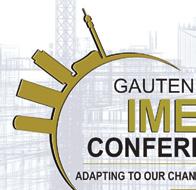


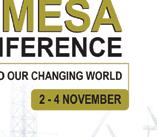

















DATES: 2-4 N ovember 2022
VENUE : Birchwood Hotel






THEME: Adapting to our changing world
Register and pay BEFORE 31 July 2022
• Members: R6 700
• Non-members : R8 000
t: +27 (031)266 3263
e: conference@imesa.org.za marketing@imesa.org.za www.imesa.org.za



REGISTRATION Register and pay AFTER 1 August 2022
• Members : R7 500
• Non-members : R8 900 HAVE YOU REGISTERED FOR THE
















































EARLY
BIRD REGISTRATION
STANDARD
IMESA
CONFERENCE YET?
IMESA ORGANISER THE INSTITUTE OF MUNICIPAL ENGINEERING OF SOUTHERN AFRICA (IMESA) CONFERENCE ENDORSED BY
EVENT: 85 TH I MESA Conference
Earn 2.5 CPD points
attending
today.
advantage of the EARLY BIRD RATE
SAVE! CONTACT US FOR DETAILS
by
Register
Take
and
Working together to shape a BETTER WORLD

August is Women’s Month in South Africa and provides an opportunity to celebrate our role as vital change-makers in society.
This year’s South African theme was ‘Women’s Socio-Economic Rights and Empowerment: Building Back Better for Women’s Improved Resilience’. Simply put, it is about breaking down barriers, and freeing women from discrimination and gender-based threats – themes that were also reflected in various International Women’s Day (IWD) initiatives for 2022.
The UN’s 2022 IWD theme was ‘Gender Equality Today for a Sustainable Tomorrow’. Another theme run by a private sector funded IWD programme was #BreakTheBias. Both themes sum up the objectives for global transformation as a year-round movement in line with UN Sustainable Development Goal 5 on gender equality.
The reality is that girls and women in South Africa – and globally – still face various degrees of bias influenced by factors such as cultures and customs, access to education, financial circumstances, mentorship, and government policy. Bridging the gaps needs ongoing awareness and collaboration, plus equal opportunities for girls to benefit from STEM programmes starting at primary level.
IMESA’s standpoint
Within IMESA, we are committed to inclusivity and the empowerment of women, with a renewed drive on creating that crucial mindset shift. Our contributions include education and training, as well as bursaries for qualifying students.
As the first woman president of IMESA, since its founding in 1961, I’m especially honoured to have been able to help move the agenda forward, along with my counterparts within the International Federation of Municipal Engineering (IFME) – of which IMESA is a member.
It’s also significant to note that IFME recently elected their first woman president, Sanne Hieltjes, who is based in The Netherlands. I’m pleased to confirm that Sanne will be a keynote speaker at our upcoming IMESA 85th Annual Conference in November 2022, where she’ll share some of her thoughts and experiences within the municipal engineering arena.
The ultimate multitaskers
Like many women in my field, I am a wife, mother, engineer and manager. And as any woman knows, raising a family and building a career is never easy. The fact that I’ve been able to do both is due to a combination of factors, which started during my formative years in India. Encouraged by my parents, I decided to enroll for a BSc in Civil Engineering at South Gujarat University.
Although it wasn’t common for women to study engineering, the door was still open to anyone with interest and aptitude. As a first-year student, I started out with a class of around 500, of which only 12 were women. Most, if not all, went on to pursue successful careers.
In my case, and after several years working in the Indian construction sector, my path led me to South Africa where I joined eThekwini Municipality in 1997 as a structural engineer. My manager at the time identified my passion for water and sanitation infrastructure and encouraged me to specialise in these disciplines. The rest is history. Along the way, I’ve been blessed by a son and daughter, both of whom are now qualified medical doctors.
Hard Hats and Stilettos
The point to emphasise is that women have as many skills and abilities to contribute to all work environments and should not be subjected to
stereotypes in terms of which vocations are most suitable based on gender. Those were among the topics presented during our IMESA Women’s Day Breakfast in Durban.
Themed ‘Hard Hats and Stilettos – Getting the Job Done’, it was a wonderful opportunity for women to share what it takes to succeed in a technical field. The keynote speaker was Mabuyi Mhlanga from Sanral, who presented an inspiring talk on the planned upgrades and innovative engineering required for the EB Cloete Interchange N2 North and N3 West in eThekwini.
The fact that more woman engineers are now leading in senior roles is encouraging, both from an equity perspective, as well as in developing frameworks where woman team members can contribute to achieving the critical solutions needed to make a real difference in this fastchanging world.
Women are now major influencers in helping to shape our built environment. We just need to accelerate the process so that men and women – together – can excel and in turn empower their children and communities.

IMIESA August 2022 5 PRESIDENT’S COMMENT
IMESA
Bhavna Soni, president, IMESA

Solutions for SUSTAINABLE ASPHALT

It is not an option to continue as normal and wait for the tide to turn,” says Bennie Greyling, CEO, AECI Much Asphalt. “As a company, we are proactively preparing for what will be a very different future.”
He points out that the Covid-19-induced shutdown of the asphalt industry has been followed by several other potentially devastating impacts. “Delayed and cancelled road construction and rehabilitation projects are now normal for various reasons, despite the public outcry on the condition of our roads,” says Greyling.
Also threatening asphalt and binder production is the fact that only one South African refinery, NATREF, is currently producing petroleum-based products. “We are therefore
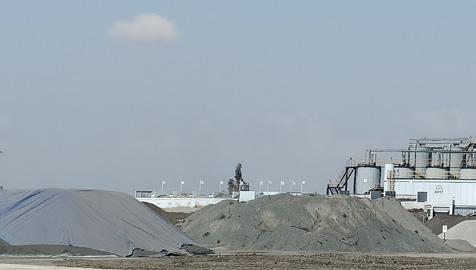
Within an environment currently characterised by significant risks, AECI Much Asphalt is putting its focus firmly on sustainability in response to the challenges faced by the asphalt industry following the Covid-19 pandemic.
importing bitumen on a large scale and putting extensive measures in place to ensure that we receive quality products to adhere to our stringent specifications,” Greyling explains.
Advantages of bitumen
Greyling adds that bitumen, as the bottom of the crude oil barrel, is the only crude component material that does not require further combustion processing to be useful in everyday life.
“Refined fuels, comprising the remainder of the barrel, are essentially ‘burnt’ during singleuse activities such as heating or transport, adding significantly to the emissions count during their use. Bitumen used during asphalt production does not contribute further to carbon emissions, but instead is neutralised during its many years of useful life in a roadway in its natural state as it was obtained from the refining process,” says Greyling.
AECI Much Asphalt subsidiary AECI SprayPave now produces 10/20 penetration grade bitumen through its multistage bitumen converter in Cape Town – one of only two in the world – using feedstock bitumen from NATREF or through importation.
“This capability is critical to us at present, with no other source of 10/20 penetration grade bitumen available in South Africa,” Greyling points out.
To remain sustainable in increasingly challenging market conditions, AECI Much Asphalt is also exploring new business opportunities, investigating strategies to replace non-renewable aggregate materials
in the manufacture of asphalt, and putting measures in place to conserve energy and reduce its carbon footprint.
“Broadly, we aim to seek non-traditional revenue streams, expand our footprint into Africa, and focus on operational efficiencies to remain a best-cost and quality producer,” he explains.
“I am very proud of our teams who are demonstrating their commitment by putting safety first despite all the setbacks of the past few years. Our safety record has improved from one of the worst in the AECI group to one of the best. This is a great platform on which to build our future.”
Driving sustainability
The drive to sustainability for AECI Much Asphalt goes further than the company’s bottom line. Greyling believes that as a leader in the South African asphalt industry and the biggest commercial supplier of asphalt in sub-Saharan Africa, the company has a responsibility to pioneer new and more sustainable, environmentally friendly products that also improve quality, longevity and safety for users.
Aggregates extracted from the earth such as sand, gravel and crushed stone make up about 95% of an asphalt mix by mass. “The need to explore alternative materials that can reduce our industry’s dependency and impact on the environment is critical,” says Joanne Muller, regional technical manager: Gauteng, AECI Much Asphalt. “When the solutions also reduce waste streams that are not recycled into other materials or products, this is a step in the right direction.”
The material most often recycled in the asphalt industry consists of existing sections of road that are milled out due to upgrade or rehabilitation. Most new asphalt produced at
COVER STORY
6 IMIESA August 2022
Trial at the University of Pretoria in collaboration with the CSIR, using nonrecyclable waste plastic as an aggregate and binder modifier in the asphalt

AECI Much Asphalt’s production plants around South Africa contains between 5% and 20% reclaimed asphalt.
“An extremely small proportion of reclaimed asphalt goes to waste, reducing not only the dependency on virgin aggregate from quarries, but also the volumes of virgin bitumen required from fossil fuel industries,” Muller points out.
Slag and tyres
AECI Much Asphalt’s extensive footprint has enabled some of its production facilities to leverage other aggregate streams to reduce the use of virgin aggregates. One example is the plant in Witbank where several asphalt products are manufactured using recycled slag aggregates.
Slag aggregates are obtained by processing waste material from smelting operations in steel manufacturing, among others. The waste consists mainly of the flux used to remove the impurities and/or non-ferrous constituent materials from the ore. The replacement of approximately 20 000 t of virgin aggregate with slag aggregate annually over several years has contributed greatly to the drive for sustainable use of materials at this plant.
The use of recycled ground tyre rubber into asphalt mixtures at several AECI Much Asphalt production facilities has multiple benefits. It reduces the volume of virgin bitumen used by replacing about 20% of the binder in the asphalt, aids pavement longevity, reduces noise pollution on the road, and results in fewer tyres going to landfills.
Pushing the boundaries
Some years ago, assessments by the CSIR and AECI Much Asphalt showed the use of non-recyclable glass to be technically viable as a partial aggregate replacement. Certain low-impact niche applications were identified
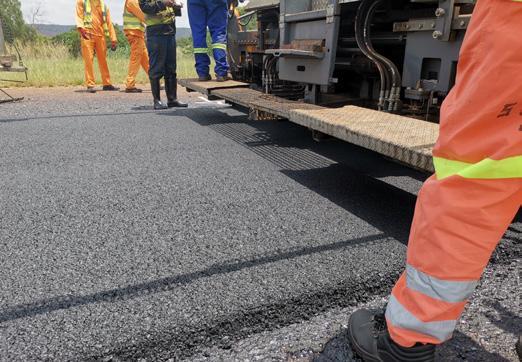
for further exploration and AECI Much Asphalt is collaborating with Interwaste, an integrated waste management provider, in investigating alternative recycling streams for glass waste destined for landfills.
An upcoming trial will involve the production of 20 t of hot mix asphalt, incorporating 10% waste glass, at the Eerste River plant for placement on walkways at the Strand Golf Club in the Western Cape.
Together with the CSIR, AECI Much Asphalt is also actively tackling the significant problem of waste plastics. Two full-scale trials done to date have focused on the proportion of nonrecycled and non-recyclable waste plastic that can potentially be used as an aggregate and binder modifier in asphalt.
Aspects considered include the potential presence of microplastics that may contaminate water courses. However, data to date shows product performance improvements and no environmental contamination.
Energy efficiency
As the production of hot mix asphalt requires heating to temperatures in excess of 140˚C, energy used is a significant factor in the cost and environmental impact of the final product.

IMIESA August 2022 7 COVER STORY
Ultra-thin porous surfacing with A-R 2 (warm mix ground tyre rubber binder) on the N5 in Harrismith, supplied by the Bloemfontein plant
The mix that went down in the first trial by AECI Much Asphalt using non-recyclable plastic
Much Asphalt’s Benoni flagship facility


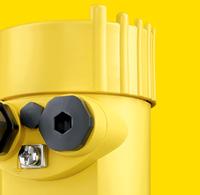




THREE INTRINSIC VALUES: ACCURACY, RELIABILITY AND EASE OF USE. THE 6X ®. OUT NOW! Admittedly, at first glance, you can’t tell what’s inside the new VEGAPULS 6X radar sensor: A high-precision level instrument that doesn’t care if its measuring liquids or bulk solids. Only its colour gives you a hint that it’s going to be great to use. VEGA. HOME OF VALUES. www.vega.com/radar

“We are continually exploring improvements to the energy efficiency and carbon footprint of our operations,” says Muller. “Our first grid-tied solar installation was recently commissioned at the AECI Much Asphalt Benoni plant laboratory and offices.”
This pilot project for the group will now be extended to include the Gauteng regional offices and the regional laboratory, in turn expanding the overall impact footprint to other production facilities in the group that use the regional facilities.
Bitumen heating is one of the main consumers of energy at asphalt plants. The Benoni facility already uses natural gas in place of burner fuel to dry and heat material during the production
of asphalt. This plant is now conducting a feasibility study into gas generator technology to replace standard heat sources for bitumen heating. A potential CO2 emissions reduction of up to 50% is anticipated from this process.
The project entails the design, manufacture and installation a 201 kVA combined heat and power gas generator to power the heating of the bitumen tank farm for the site. Scavenged heat from this fixture will serve as an alternative heat source in the manufacturing process, with significant positive impacts for product quality and timeous delivery to sites.
All AECI’s business activities are underpinned by the group’s BIGGER values of being Bold, Innovative, Going Green and being Engaged
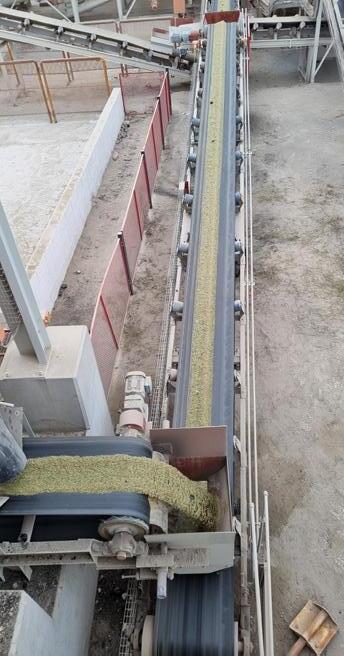
Asphalt core containing waste glass and Responsible. AECI Much Asphalt is confident that its drive for sustainability meets every one of these values.

www.muchasphalt.com

Recycled asphalt feeding from the screening plant

COVER STORY
IMIESA August 2022 9
Hot mix asphalt trial incorporating waste glass
GETTING THE BEST VALUE
from BIM investments
Building information modelling (BIM) continues to evolve into all facets of the global built environment; however, in South Africa, more widespread adoption is needed to effect meaningful digital transformation.
By Alastair Currie

The key advantage of BIM is that it enables enhanced, cloud-based data sharing and collaboration in unprecedented ways by multidisciplinary project teams to plan, design and construct structures ranging from buildings and roads to industrial complexes and wastewater treatment plants,” explains Tammy Venter, PrArch, AEC team lead and BIM implementation specialist at Modena Design Centres (Durban). Modena is an Autodesk Platinum Partner and provider of architecture, engineering and construction (AEC) consulting services.
“BIM is an intelligent virtual process that passes on significant time, cost and quality benefits, but implementing it effectively requires a culture change within the construction industry, as well as within individual organisations,” Venter continues, adding that BIM adoption also needs to be driven more at tertiary level to prepare nextgeneration professionals.
Technology leaders
“For BIM to work within organisations, the transition process needs to be led by its business leaders and adopted holistically, working in conjunction with their design and project teams,” Venter explains. “Ideally, the process should be spearheaded by a BIM leader, chief technology officer or similar to select the right people, processes and software tools.”
While some may view the adoption of BIM methodologies and technology as an unnecessary added cost, Venter says that once organisations experience the productivity benefits, there is a permanent transition from traditional standalone 2D and 3D design practices.
BIM goes beyond 3D design to incorporate time, cost and as-built drawings – respectively referred to as 4D, 5D and 6D – within a real-world simulation model that can be accessed by project team members that include the architect, design engineers, quantity surveyors, contractors and subcontractors. Working in the cloud, all stakeholders are able to collaborate in one environment and draw data from a single source of truth, maximising productivity benefits and project predictability.
Optimising workflow
“With BIM, you build what you envision, aided by a series of software tools to interrogate, test and validate. The selection tools will depend on the nature of the business. For example, architects and engineers will each have their own specific requirements,” Venter explains.

Modena’s consulting services determine the optimal IT infrastructure requirements in conjunction with fit-for-purpose software, supported by ongoing education and training.
At the centre is Autodesk’s BIM software, which enables the importing, rendering and management of data during the
BIM TECHNOLOGY
Tammy Venter, AEC team lead and BIM implementation specialist at Modena Design Centres, Durban
10 IMIESA August 2022
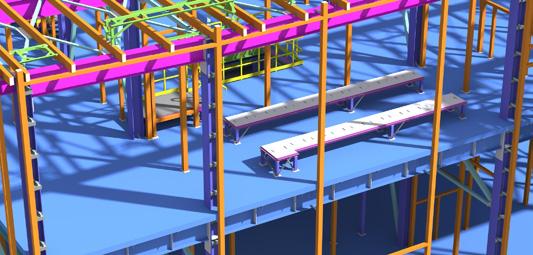
design, construction and operations phases. The detailed 3D digital models created can communicate seamlessly with the Autodesk and competitor CAD software packages on the market.
A major plus is that, as the design stages develop, the BIM model is continually updated in real time with fresh data to incorporate revisions in terms of aspects like elevations, plans, sections and schedules.
Venter says that a growing number of construction companies in South Africa are switching to BIM to streamline their interdepartmental collaboration on projects and avoid duplicating data. BIM’s cloud-based approach also enables engineering firms to communicate effectively between the design office and site teams as construction progresses.
A culture of learning
Successful BIM implementers embrace learning as a culture and understand that the internet of things is rapidly changing how built environment professionals interpret data during their modelling, design and project execution processes.
“Errors and the need for rework can be significantly reduced, with projects completed on time and within budget,” Venter continues, adding that BIM workflow data, along with Autodesk Construction Cloud’s data management system, can also prove invaluable in arbitration disputes.
In preparation for BIM training and implementation, Modena’s approach starts off by getting to understand the client and their internal structures. “We then identify key players that we believe will be instrumental in facilitating BIM integration, leading the change within their organisation,” she explains.
“Translating an organisation’s CAD processes into a BIM environment can be challenging and it takes time. Our training support is therefore crucial as team members experience their first live BIM project. Over time, our role is to facilitate the cross-pollination of knowledge to
the point where organisations can thrive independently,” Venter explains.
Adding predictability
BIM is a concept, methodology and process that has redefined project and programme management. This is an especially important factor within the current inflationary environment, where price escalation is unpredictable.
“BIM – by its nature – provides a high level of predictability and repeatability. Going forward, artificial intelligence will play a key role here in manipulating and automating processes. However, the human interface is what drives the process,” Venter continues.
Asset and facilities management
Asset management and facilities management are also being enhanced with BIM to create more cost-efficient and greener structures.
“There are BIM software modules – such as Archibus and SpaceIQ – that enable facilities managers to access a database of parts and components, as well as specific serial numbers, warranties, guarantees and manuals. You can also calculate energy consumption as well as future operations and maintenance costs,” says Venter.
Within the world of BIM, the ISO 19650 standard series maps out the framework for optimally managing information over the entire life cycle of a built asset, irrespective of its scale. This includes upfront planning, design, engineering, construction, document management, refurbishment and end-of-life.
“Once mastered, BIM is not complicated; it’s just geometry with information attached to it to create a single source of truth. BIM interfaces with any environment that requires information, like database management, GIS, 3D scanning and digital twinning platforms. Essentially, and thanks to digital technology, BIM takes us into an exciting new world of better information management,” Venter concludes.
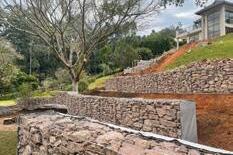


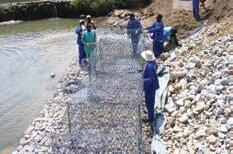


Gabions and River Mattresses
Gabion Rocks
Hexagon Wovenmesh
Square Weldmesh
Geotextiles
Gabion Tool Sets
Biodegradable Soil Blankets
Soil Bioengineering
Sandbags
Gabion Barriers


011 882 5788 www.gabionbaskets.co.za
ISO 19650 IN SOUTH AFRICA
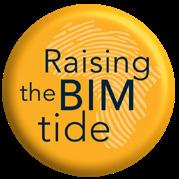
The
importance of pursuing global BIM standardisation and certification trends

We are currently facing a global evolution of professional work. With the rise of the Fourth Industrial Revolution, and the buzz around the potential impact of artificial intelligence, machine learning and big data, there are still many professionals in the architecture, engineering and construction (AEC) space asking, “What is BIM?”
By Astrid van der Laan*
Building information modelling (BIM) – a collaborative process involving the generation and management of digital representations of physical and functional characteristics of places –is a concept that has been in development for a few decades, gaining prevalence in the early 2000s. The ongoing development of standards surrounding BIM has led to the international ISO 19650 standard.
Adapted and developed from the UK PAS 1192 standards, the ISO 19650 standard suits both vertical and linear project approaches. Thus, it is relevant to all stakeholders within the AEC industry.
ISO 19650 ‘Organisation and digitisation of information about buildings and civil engineering works, including BIM’ currently consists of several parts, with some still in development. ISO 19650-1:2018, namely Part 1 ‘Concepts and Principles’, is currently
a SABS Draft Standard – the public enquiry stage ended on 31 July 2022.
Existing standardisation within the AEC industry, construction contracts, building methods and professional titles are well established and regulated. But there is no agreed-on consensus as to what a BIMcapable individual or organisation should be able to do. And, erroneously, BIM has become synonymous with software competencies. The current lack of a unified
12 IMIESA August 2022
BIM TECHNOLOGY
JOIN US!
BIMcommUNITY.Africa brings together all built environment industry stakeholders. We are a rallying point for BIM initiatives in the country and are currently driving the adoption of ISO 19650 through the SABS. We are in the process of garnering support for a BIM Codesa – an initiative that brings every stakeholder in the built environment together to craft a way forward to achieve the Digital Transformation of the Built Environment.
We welcome any person or company to join us and help us Raise the BIM Tide. Join BIMcommUNITY. Africa and stay abreast of the latest developments. Email angela@bimcommunity.africa or visit www.bimcommunity.africa.

framework leads to a focus on technology. BIM processes may indeed make use of the latest technology; however, technology should not be the driver.
Those of us making use of BIM tools and processes have considered working collaboratively in tandem, but we often end up adding an extra layer of complexity, with additional software solutions, extra modelling requirements and 3D collaboration deliverables – all over and above the existing documentation and contractual obligations surrounding a built project.
Bearing in mind that there is currently no globally agreed-on specification against which an individual can be ISO 19650 BIM accredited, there definitely is a need to seek training and certification.
At present, there are nowhere near enough ISO 19650-BIM-savvy people within the AEC industry to make BIM processes business as usual. The current ISO 19650-ready practitioners need a much larger majority of people throughout the industry to upskill and maintain the momentum required to see the standard adopted successfully.
So rather than being part of the crowd waiting until they’re forced to learn, it is highly beneficial to peruse any relevant training now. This will benefit not only an individual, but their organisation as well as the entire AEC industry, which will be better off for it.
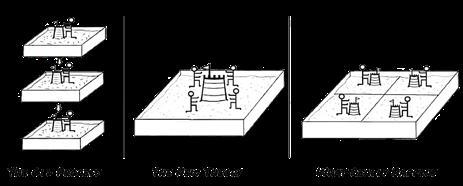
“One of the things we’re working on as a community is to work across the whole value chain to assess what information each stakeholder requires, ensuring every stakeholder has all the information relevant to them. Then we move from ‘information for information’s sake’ to ‘the right information, to the right person, at the right time’.”
– Angela Lang, BIMcommUNITY.Africa
Key criteria
The following are what to look for in BIM certification programmes:
• It’s not about attendance certificates, but demonstrated capability.
• It’s not about what software to use, but the information to exchange.
• It should focus on the information management process, not the data generated.
Increasingly, such training should also address the need for improvement of soft skills for information managers, who are driving the digital transformation within an organisation. However varied the roles of individuals seeking certification, ISO 19650 is ultimately about information management.
There are over 40 activities within an allencompassing ISO 19650 standardised information management process, and no one person has the capability, capacity nor authority to undertake all of them. Over half of these activities are upstream of BIM model production. No one person is an expert in the entire process, one just needs to understand how to undertake their role effectively. Seeking ISO 19650
certification is but one pillar in organisational accreditation; companies that already focus on well-organised and thorough workflows for managing information are well on their way.
Information and business goals
An organisation should be able to demonstrate capability and capacity to undertake a role; confirming that specific people on a specific project have been evaluated for their roles. It should also align information goals to business goals, identifying defective workflows and mitigating negative effects, rather than just advocating the positives of successful BIM implementation.
Accepting ISO 19650 Part 1 nationally is only the first step. Understanding that the implementation strategies surrounding the standards are still developing is critical. We are all learning, implementing and trying to do things better. Rather than implementing something different for every built project, let’s get everyone behind the same standard. Let’s move the industry past the question: “What is BIM?”
*Principal computational designer, Zutari, and member of BIMcommUNITY.Africa
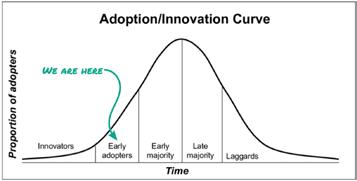
The Rogers Adoption Curve
(Source: https://www.researchgate.net/figure/Adoption-Innovation-CurveAdapted-from-Rogers-1995_fig3_228757766)
IMIESA August 2022 13
BIM TECHNOLOGY








































TPrecast concrete system








his system enables various trades to work simultaneously, saving construction time in the process. Using cast-in-place methods, work starts with the construction of the concrete floor slab, followed by the wall and ending with the roof.
















The roof and wall of a 25 M ℓ reservoir were erected recently, in as little as three months after the cast-in-situ floor, as were the bases for the precast concrete roof structure and ring foundation, which were completed by the principal contractor. This reservoir has an inside diameter of 65.2 m and water height of 7.8 m. The roof column grids for the roof slab and beam span are 10.87 m by 10.87 m.




ACCELERATES RESERVOIR CONSTRUCTION

The construction of reservoirs ranging between 10 Mℓ and 60 Mℓ in size is being significantly accelerated using a unique precast concrete system that was designed in South Africa.





The system harnesses the precast concrete design skills and experience of Infinite Consulting Engineers and Corestruc’s know-how in concrete design and application, as well as rigging and erection. It is manufactured by precast companies that have been approved by Corestruc to ensure a final structure of the highest possible quality.




By Willie de Jager, Kobus Kotze & Tian de Jager


appropriately maintained. This is considering that the concrete used to manufacture the various prefabricated elements that make up the system has a permeability index that far exceeds 10, a sorptivity index well below 6 mm/√h, and a chloride conductivity of less than 0.75 mS/cm.












These reservoirs have been designed to provide up to 100 years of service if they are







Self-compacting concrete is used to manufacture elements that contain significant reinforcing and where conventional vibrating pokers cannot be used effectively. Trial mixes are prepared and tested for strength and durability, while also taking into consideration the workability of the concrete. Working in controlled factory environments, the perfect dosages of admixtures are also achieved to ensure timely strength development, which is imperative for uninterrupted production.









In these factories, the perfect water-tocement ratio is also maintained to ensure concrete strength. Moreover, aggregates


















from suitable suppliers are graded appropriately to avoid early concrete shrinkage.
The prefabricated elements are inspected and approved for dispatch to ensure the accuracy of the placement of the cast-in components. Reinforcement bar size and placement are also verified as part of the quality control procedures at the approved factories.

Setting out and installation
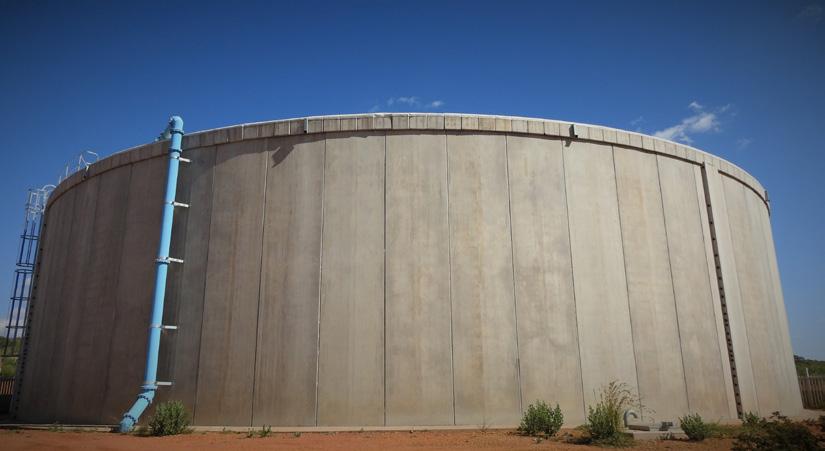
These steps are complemented by the checks and balances introduced by Corestruc ahead of mobilising to site to commence erecting the structure. The company manages the setting out and installation of the column anchors for the precast concrete roof. By confirming the dimensional accuracies before erection, the company ensures that the beams of the roof structure fit the first time round. The precast concrete wall panels are placed and positioned in a similar manner with the assistance of permanent locating plates that are fixed to the ring foundation. As an extension of the principal engineering consultant’s office, Infinite Consulting Engineers provides professional project input. The firm also collaborates































C M Y CM MY CY CMY K
WATER & WASTEWATER
14 IMIESA August 2022
The precast concrete system consists of a prefabricated roof and wall













































with the engineering team to ensure that the various aspects of the work scope integrate seamlessly to avoid delays. Moreover, Infinite Consulting Engineers approves and accepts liability for the final precast concrete structure.








Constructing the roof structure






The roof structure consists of hollow-core slabs that are placed on precast concrete beams, which are supported by prefabricated columns. They are connected to the in situ bases by components that are cast into the precast concrete columns, also referred to as column shoes.









Similar to the construction of a conventional steel structure, the precast concrete columns are connected to hold-down bolts in the base. Suspended precast concrete beams are then installed on to the columns. They are secured with dowels that protrude from the columns.
The hollow-core slabs are then installed on to the beams and secured in place. This is achieved by tying the steel reinforcing and placing in situ concrete into the cores of the prefabricated slabs. Stirrups protruding from the precast concrete beam act as a





mechanical interlock to form a composite mechanism with infill concrete.
Using traditional methods, a reservoir roof is the most complex and timeconsuming aspect of the entire build. It is undertaken once the wall and in situ columns reach their final height. Many tonnes of scaffolding must be installed inside the reservoir to support the forms for the frame of the roof structure. The extensive associated reinforcement and concrete works, including placement and stripping of the shutters, also requires close and careful management. This is in addition to the timely coordination of the concrete trucks to site for the continuous concrete pours.



Circular walls

















The circular precast concrete wall comprises panels that have been prestressed vertically. They feature 32 mm diameter polyvinyl chloride sleeves that have been positioned according to the post-tensioning design.








The panels are placed into position and then supported by push-pull props and
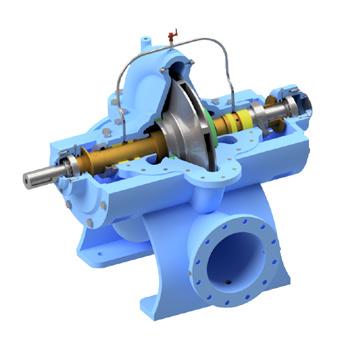
steel brackets at the top of each. Unbonded cables are pushed through the sleeves, which are then grouted monolithically with the joints of the panels.


The grout is poured continuously in-between the wall panels and horizontal cable sleeves. It is important to achieve a high-strength, high-flow grout with an extended pot-life and free of segregation. To achieve this, the water-to-cement ratio of 0:37 is manipulated with the use of admixtures and the water temperature reduced and controlled to act as a chiller in the mix. Furthermore, only cement is used in the grout mix, which also contains an unhydrated cement that reacts with water and seals possible leaks.






After the grout has cured to a strength of 80 MPa, the cables are stressed to 75% via precast concrete buttress panels that have been spaced along the perimeter of the reservoir.



The wall is then pinned by casting a 200 mm to 250 mm high reinforced kicker on the wall footing on both sides of each panel. Joints between the panels are grouted with a high-flow, high-strength








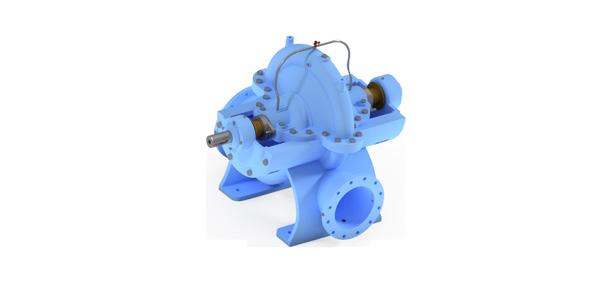
Operating Range
Flow - 10m³/hr up to 2500m³/hr
Head - 4m up to 120m
Applications - General liquid pumping - Power plants - Bulk Water - Steel mills - Refineries - Chemical plants - Cooling and heating systems

WATER & WASTEWATER www.matherandplatt.com
ISO 9001.2015 +27 11 824 4810 +27 83 676 5904 26 Nagington Road, Wadeville
APE Pumps Split Case Pump
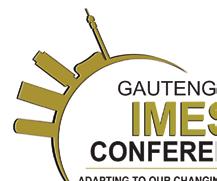







Register and pay BEFORE 31 July 2022

• Members: R6 700
• Non-members : R8 000



• Members : R7 500
• Non-members : R8 900





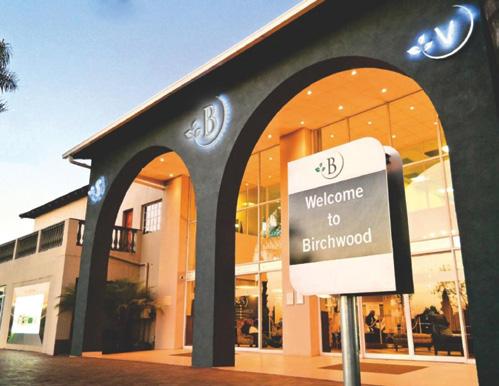







Birchwood Single: R1 000
Birchwood Sharing: R1 200 Silverbirch Single: R1 100 Silverbirch Sharing: R1 300
Birchwood Single: R1 250
Sharing: R1 700 Silverbirch Single: R1 350 Silverbirch Sharing: R1 800











BED
& BREAKFAST
t: +27 (031)266 3263 e: conference@imesa.org.za marketing@imesa.org.za www.imesa.org.za IMESA ORGANISER THE INSTITUTE OF MUNICIPAL ENGINEERING OF SOUTHERN AFRICA (IMESA) CONFERENCE ENDORSED BY EVENT: 85 TH I MESA Conference DATES: 2-4 N ovember 2022 DINNER, BED
EARLY BIRD REGISTRATION
& BREAKFAST
Birchwood
STANDARD REGISTRATION
Register and pay AFTER 1 August 2022
BOOK YOUR accommodation NOW Hotel rates are noncommissionable if
book
used is IMESA CONFERENCE.
subject
availability. www.birchwoodhotel.co.za
delegates
through travel agents. Bookings to be done directly with Hotel. Reference to be
Rooms are
to

Are we driving a car without a fuel gauge?
Groundwater is the most extracted material in the world, providing about half of the drinking water supply worldwide. Locally, it might be considered less important, given that only 13% of all water used comes from aquifers. However, most of the drier western part of the country is dependent on groundwater for its water supplies. More than 400 cities, towns and villages in this country use groundwater – either as a sole source or in conjunction with surface water supplies. And almost all rural water supply schemes are groundwater driven, with the development of springs and shallow boreholes fitted with handpumps being a key.
Recent droughts in the Southern Cape (2009-10), Western Cape (2016-19) and Eastern Cape (ongoing since 2015) have seen municipalities, businesses and individuals turn to groundwater in the face of potentially failing municipal water supplies. Its ubiquitous nature and the ability of most rock types to store and transmit water make groundwater exploration an obvious mitigation action in many instances. It is a renewable resource and resilient against
the effects of drought, but it needs to be used within its sustainable limits.
Challenges
The use of groundwater is not without challenges. Unlike a dam where water is drawn at a single point, groundwater is unevenly distributed underground in both quality and quantity. It has to be abstracted from multiple locations, transported to a single point and then reticulated to users.
Furthermore, groundwater does not benefit from the economies of scale when compared to large dams, but the cost of development of groundwater supplies is typically much less than its surface water counterparts. The management of groundwater schemes is typically more labour-intensive, requiring regular interventions to keep the systems running smoothly.
Possibly the biggest challenge related to the development and use of groundwater is that it cannot be seen. It is invisible to those who haven’t specialised in this field and, as a result, is poorly understood. In their book, Groundwater Around the World, Margat and Van der Gun observe that what most people know about groundwater is not in proportion
Groundwater management is critical to keeping water supplies available and safe for future generations.
By Dr Roger Parsons

ABOUT THE AUTHOR
Dr Roger Parsons is a hydrogeologist with almost 40 years’ experience. He is the director of Parsons & Associates Specialist Groundwater Consultants and former provincial branch chair of the Ground Water Division. He was awarded the Ground Water Medal for outstanding service and dedication to furthering the science and technology of groundwater.
to the use they make of it. Groundwater resources are often poorly assessed and hardly managed. In some parts of the world, the resource is excessively exploited and wasted, but elsewhere groundwater is underestimated and unused.
Department of Water and Sanitation
The Department of Water and Sanitation (DWS) used to have a division of experienced
18 IMIESA August 2022

The diligent collection of data and having it reviewed by a hydrogeologist is key to successfully managing any groundwater scheme. This requires approximately eight hours of their input each year. It is also prudent to include a hydrogeologist in the commissioning process to check that the scheme has been implemented correctly, but thereafter the review can be done every 6 to 12 months.
The DWS has been restructured around the National Water Act (No. 36 of 1998) and this expertise now sits in the private sector and, with only one or two exceptions, municipalities are devoid of this expertise – even when their entire water supply is sourced from underground.
During the drought that resulted in Cape Town facing ‘Day Zero’, the Western Cape Provincial Government assigned hydrogeologists to each support four or five municipalities as they sought to mitigate falling dam levels and dry taps. The purpose of this was to guide better decision-making and promote a better return on their investment when contemplating groundwater development or expansion. In my opinion, this was a wise move, but it needs to be extended if headway is to be made against the lack of groundwater management at municipal level.
A recent visit to a R150 million groundwater scheme in the Eastern Cape reminded me of the sorry state of affairs of groundwater management. Five boreholes are being used
South Africa hydrogeologists who developed groundwater resources and provided support to municipalities. At the time, it was also the training ground for most hydrogeologists in the country.
to supply groundwater to the town, all fitted with flow meters. This is a requirement of the DWS, either as a licence condition or under various regulations governed by them. The purpose of the flow meter was not clear, as the borehole was being pumped at 7.8 ℓ /s when the pumping rate recommended by the hydrogeologist was 5.0 ℓ /s. Despite the cost of the scheme, R50 000 could not be found to install data loggers in each borehole. Data loggers are used to measure the groundwater level over time, which in turn provides a measure of the reaction of the aquifer to pumping and the sustainability of the abstraction.
Operating a production borehole without this information is like driving a car without a fuel gauge. It is guaranteed that you will run out of fuel at some stage. In this example, the borehole may continue to deliver 7.8 ℓ /s for a day, a week or even a month but, at some point, the borehole will fail and the residents of the town will be without water. Groundwater will probably be blamed and declared unreliable.
Managing groundwater
Managing groundwater is not complicated. A set of operating rules (like rate of pumping) needs to be specified from the outset.
The availability of hydrogeological capacity is not a limitation. The Ground Water Division has more than 300 signed-up members, most of whom are skilled and experienced in groundwater management. Many graduates that have completed groundwater-focused courses battle to find employment. A programme where an intern is tasked with managing four or five municipal groundwater supply schemes is an ideal way for young hydrologists to gain work experience while overcoming the lack of groundwater management. We just need visionary leadership.
A data logger is suspended in a 40 mm PVC pipe installed in the borehole at a level directly above the pump inlet to monitor aquifer response to pumping and assess the sustainability of the groundwater use
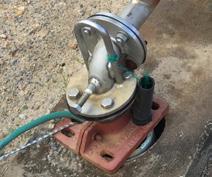

WATER & WASTEWATER
SOUTH AFRICA’S POWER GAP Taking action to bridge

Unveiled by President Cyril Ramaphosa on 25 July 2022, South Africa’s latest energy action plan provides a more immediate response to the country’s power crisis and opens the door for widespread private sector participation.
What was great about the President’s speech was that he has opened the energy challenge to a shared solution with opportunities for everyone to have an impact, no matter how small,” says Janice Foster, market managing director: Energy, Zutari.
A highlight of the plan is the doubling of new generation for Bid Window 6 of the Renewable Energy IPP Procurement Programme (REIPPPP) from 2 600 MW to 5 200 MW. Zutari has supported client projects in all REIPPPP bid windows to date, including the latest round.
Another significant step is removing the licensing threshold for embedded generation capacity entirely. Raising the threshold to 100 MW last year has already unlocked a pipeline of more than 80 confirmed private sector projects with a combined capacity of over 6 000 MW. “This is a significant increase in capacity for private offtakers, which we expect to see starting to come online in the coming months,” says Foster.
Priority focus
She stresses that preferred projects in Bid Window 5 should be prioritised. “These have already been awarded and in theory would be the quickest to get online if we can overcome the obstacles to those achieving financial close.” Foster adds that Bid Window 6 projects are anticipated to factor these constraints into their costing and delivery.
Another important move is the announcement of an Eskom feed-in tariff for small-scale embedded generation. “That is a real signal of incentive to Eskom’s commercial users and private residential customers that they can also contribute and support their own needs at the same time,” says Foster.
Government’s planned battery energy storage initiative to supplement Eskom’s capacity also represents a multifaceted approach to the energy crisis. “This opens up the energy storage market to private investment. The addition of battery energy storage systems will support the grid by catering for peak shaving, providing network stability,” Foster continues, adding that these systems will enable greater penetration of renewables into the future.

An equitable transition
While the current energy crisis is the result of years of load-shedding, the situation is not unique to South Africa. “Globally, we see different parts of the world facing energy challenges that might look different but are based on some of the same fundamental issues,” she explains. These include the shift from coal-fired power plants.
“It is a global imperative for the world to reduce its reliance on carbon-intensive energy solutions. This is a problem likely to be with us for the foreseeable future. It entails both an energy security challenge and the need to reduce the carbon footprint of our energy supply,” explains Foster.
A ‘just’ energy transition is probably the most important consideration from a local perspective. “The bulk of our power supply is still coal-based. As we transition away from fossil fuels, we need to ensure there are opportunities for the participation of all stakeholders, especially the thousands employed in the coal-mining industry. Our energy crisis is a relatively solvable problem from a technical standpoint, but the number of social and institutional challenges it brings are equally, if not more, important,” concludes Foster.
20 IMIESA August 2022 ENERGY
Janice Foster, market managing director: Energy, Zutari
EPWP candidates assist with a wiring alteration on an AMV12 switchboard control cubicle under the watchful eye of site supervisor Kaizer Sithole, at a substation in Tshwane recently refurbished by Actom Power Systems
REFURBISHING TSHWANE’S fire-damaged substations
Earlier this year, the City of Tshwane awarded two contracts worth R200 million to Actom Power Systems to revamp the Pyramid and Kentron substations following extensive fire damage. In both instances, the initial focus is on constructing new control and switchgear buildings to house the replacement equipment.
Thereafter, Power Systems will supply, install and cable up a total of 109 new 11 kV switchgear panels – 49 for Pyramid and 60 for Kentron – including associated protection schemes, a Scada overlay, and DC chargers with battery backup.
The replacement 11 kV switchboards will consist of the modern premier class AMV12
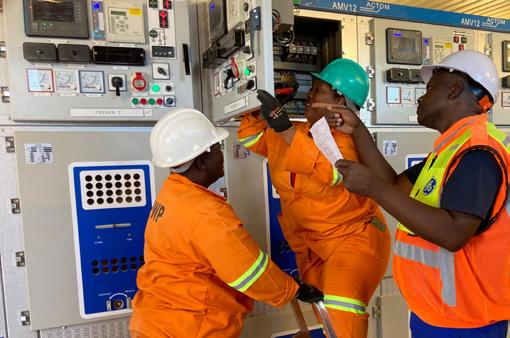
brand of switchgear developed by Actom MV Switchgear in conjunction with an international partner and now well proven in the local market.
“Impromptu repairs were carried out by the municipality to restore power supply as quickly as possible, but the longer-term security of supply shall remain compromised until permanent solutions are implemented, which is what we are doing now,” explains John McClure, GM at Power Systems.
Phased equipment upgrade
Both substations will receive a major upgrade over the three-year contract term,
as annual funds are released. New outdoor equipment includes 132 kV circuit breakers, isolators, current transformers, voltage transformers and surge arrestors supplied by Actom High Voltage Equipment. In addition, the cable and cabling accessories required for the works will be sourced from Actom Electrical Products.
For both contracts, Power Systems is obligated to involve and upskill local labour under the Extended Public Works Programme and earmark sections of work for local subcontractor participation.


The growing challenges of the climate crisis are forcing investment in green hydrogen and technologies based on it, as an essential building block for climate protection. Hydrogen, as a new promising ecosystem, can help reduce CO2 emissions in many ways.
To fully exploit the potential of hydrogen, solutions must be found to the challenges of production, storage, transpor t and use.


HILTON HOTEL | SANDTON | JOHANNESBURG Richard Morrak Executive Director 19 Edison Way, Millennium Business Park, Block A, Century City, 7446, Cape Town, South Africa Email: richard@hydrogen-africa.com Tel: +27 81 370 6495 ABOUT THE EVENT G r e e n H y d ro g e n i s o n e o f t h e l a r g e s t e c o n o m i c o p p o r t u n i t i e s o v e r t h e n e x t 3 0 y e a r s . D r i v e n b y i n t e r n a t i o n a l a c t i o n s t o c o m b a t c l i m a t e c h a n g e , i t h a s t h e p o t e n t i a l t o r e v o l u t i o n i z e n u m e ro u s v a l u e c h a i n s i n t h e e n e r g y i n d u s t r y a n d a c ro s s b o t h m o b i l i t y a n d m a n u f a c t u r i n g s e c t o r s .
ENERGY























WOMEN WINNING IN CONSTRUCTION











ERWIC AWARDS WINNERS ANNOUNCED













This year’s awards have 12 categories that recognise companies and individuals who support the gender transformation, development and mentorship of women in the construction industry.









The event was attended by the Deputy Minister of Infrastructure and Public Works, Ms Noxolo Kiviet, who congratulated the nominees and winners in her impassioned keynote address. She stated that the event, held during Women’s Month, celebrates the strength, dedication and resilience of women committed to building the country.









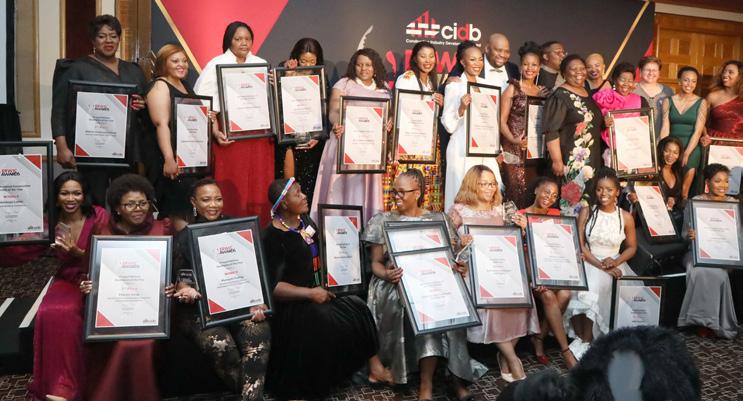





The Construction Industry Development Board (cidb) hosted the prestigious Empowerment and Recognition of Women in Construction (ERWIC) Awards on 24 August 2022.

“These awards should always stand as the clarion call for gender transformation within the construction sector, showcasing the strength of women and serving as a vision of what women can achieve








when given the necessary support,” Kiviet explained.

Bongani Dladla, CEO of the cidb, stated,







WINNERS





“The ERWIC Awards were developed by the cidb to celebrate and encourage the development of women in the construction industry. He explained that the competition at the ERWIC Awards has always been fierce, with this year being no different.





“The winners were all well deserved and stood out in their respective categories.”








Project Delivery Excellence of the Year – Grade 1









Winner: Boitsholo Trading and Projects CC for its Coega Feltex Trim Factory Pretoria project
Runner-up: Sbonzin Trading for its Upgrading of Gravel to Surface Roads, including the associated stormwater project











Project Delivery Excellence of the Year – Grade 2


Winner: Tumagole Trading Enterprise for the Renovations of the City of Johannesburg Recreation Centre project



Runner-up: Magiya Women’s Developers for their Construction of Stormwater in the Mhluzi Ward 25 project





Third place: Letsogo Trading Enterprise















WOMEN IN CONSTRUCTION
22 IMIESA August 2022




Join leading road specialists and decision makers at the 7th Regional Conference for Africa, hosted by SARF (South African Road Federation) in collaboration with IRF (International Road Federation) and PIARC (World Road Association) where we will examine and discuss ways to expand and improve our road networks, specifically in Africa, but also to then take the lessons learnt further abroad
The conference, which also includes a trade exhibition of of over 35 exhibitors, is taking place from 18 – 20 October 2022 at the Cape Town International Convention Centre under the theme Connecting Africa through Smart, Safe and Resilient Roads: Stimulating Growth and Trade on the Continent PIARC will also host two specialist seminars of vital concern on Safe and Efficient Transport by Road and The Role of Low Volume Roads in Rural Connectivity
This year’s conference brings a truly global perspective with a high number of papers submitted from around the world indicating a strong interest in the event, not only from the countries that usually attend including the UK, USA, various EU countries as well as those in the Middle East and Africa, but also from Japan, Mexico and New Zealand
Our keynote speakers include:
Mr Anouar Benazzouz – Director General of Moroccan Highways (Autoroutes du Maroc) and the first African President taking the helm of IRF.
Mr Nazir Alli – President of PIARC, World Bank Consultant and Civil Engineer, and formerly the Founding CEO of the South African National Roads Agency (SANRAL).
Professor André Roux – Head: Futures Studies Programme, University of Stellenbosch Business School
Dr Pierre Voges – CEO of the Atlantis Special Economic Zone Company and former CEO of the Mandela Bay Development Agency.


Other topics on the three-day programme include Determination of roads needs and financing mechanisms Preserving Africa's road assets Safe and efficient transport by road Innovative practices to optimise road networks Roads and the environment
The role of low volume roads in rural connectivity Capacity development in the roads sector














7 T H R E G I O N A L C O N F E R E N C E F O R A F R I C A & P I A R C I N T E R N A T I O N A L S E M I N A R O N R U R A L R O A D S A N D R O A D S A F E T Y C O N N E C T I N G A F R I C A T H R O U G H S M A R T , S A F E A N D R E S I L I E N T R O A D S 2 0 2 2 S A R F • I R F • P I A R C 2022 1 8 - 2 0 O C T O B E R 2 0 2 2 | C a p e T o w n I n t e r n a t i o n a l C o n v e n t i o n C e n t r e C O N N E C T I N G A F R I C A T H R O U G H S M A R T , S A F E A N D R E S I L I E N T R O A D S S t i m u l a t i n g G r o w t h a n d T r a d e o n t h e C o n t i n e n t W I T H T H A N K S T O O U R S P O N S O R S REGISTER NOW at www.sbs.co.za/sarf2022
Mr Anouar Benazzouz
Mr Nazir Alli
Prof André Roux
Dr Pierre Voges

Innovative solutions to AFRICAN CHALLENGES

The 7th Regional Conference for Africa, hosted by the South African Road Federation (SARF) – in collaboration with the International Road Federation and the World Road Association – will explore challenges and solutions for local and global road networks.
Under the theme ‘Connecting Africa through Smart, Safe and Resilient Roads: Stimulating Growth and Trade on the Continent’, the three-day event takes place from 18 to 20 October 2022 at the Cape Town International Convention Centre.
“While many of the papers presented will no doubt be of global value to international delegates attending, we are placing a strong emphasis on how to preserve and develop Africa’s own road assets,” says Basil Jonsson, operations director for SARF, adding that rural road optimisation is a prime example.
“Low-volume, rural roads play a hugely significant role in low-income countries, providing critical connectivity to agricultural operations. However, financial constraints often place the upgrading of these roads on the back-burner,” Jonsson elaborates.
“What solutions can we offer to both the financial and physical constraints of improving these all-important rural networks? What have other countries across the globe done to tackle these challenges? How do we assess the use of these roads and ensure that they are both safe and fit for purpose? A number of
the planned presentations will address these questions,” he explains.
Climate change, technology and transportation
Other presentations will tackle sustainability, including the impacts of climate change on road networks, as well as technological and other advancements made to optimise road transportation.
“Nanotechnology is increasingly playing a role in the development of cost-effective and sustainable road and pavement construction materials,” says Jonsson. “We are seeing an escalation in the development of alternative materials to those traditionally used in road pavements.”
As examples, Jonsson cites the trials commissioned in Ethiopia by the UK’s Foreign, Commonwealth and Development Office (in terms of High Volume Transport). These trials examine the use of long-life epoxy modified asphalt and fibre mastic asphalt road surfacing. Other independent trials conducted closer to home in KwaZulu-Natal have investigated the use of asphalt manufactured with recycled waste plastic. The findings of both studies are scheduled for presentation at the conference, as are innovative approaches for the assessment of bridges, and the collection of road traffic data.
Safety and efficiency
Safety and efficiency will also play a key role at the conference, with comparative work
being presented. This includes research on skid resistance versus surface texture, as well as possible proactive solutions to South Africa’s high road fatality rates. The latter includes the assessment of driver crash risk factors, road safety audits, and setting credible road speed limits.
International
financing and economics
Capacity development will also feature high on the conference agenda, as will financing around infrastructure. In terms of the latter, Jonsson notes: “We will hear from leading experts in international financing and economics about the comprehensive and systemic approaches other countries have adopted to identify, appraise and implement road rehabilitation projects – some of which have even developed successful public-private partnership models.”
Delegate registration
Registration to date confirms participation from Africa, the Asia-Pacific region, EU, North America, Middle East and UK. The event is anticipated to draw more than 420 delegates in total, and ECSA accreditation has been secured by SARF with 1 CPD point in Category 1 for each of the three days of the conference. Delegate registration is currently open. Special accommodation rates for out-oftown delegates have also been secured at a number of Southern Sun Hotels close to the conference venue.
For more information, contact SBS Conferences & Exhibitions on +27 (0)71 348 1780, email info@sbs.co.za or visit sbs.co.za/sarf2022.
IMIESA August 2022 25
ROADS & BRIDGES
Asphalt surfacing between Hermanus and Stanford, Western Cape (Credit: Imile van Rhyn, EFG Engineers)
Basil Jonsson, operations director, SARF
THE ROAD TO SMART MOBILITY
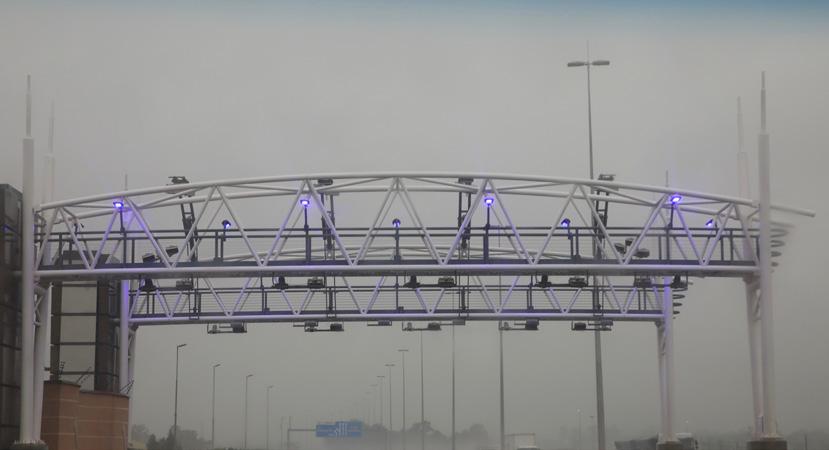
OSanral is using technology to optimise its road infrastructure. Effectively managing existing road networks can lessen the demand to build new roads.
By Kirsten Kelly

ver the past few years, we have shifted from a network provider (provision of road infrastructure as well as its maintenance and upgrades) to network manager and operator. We are using technology to effectively manage the road space. With thousands of technology options available, Sanral is focused on finding bespoke solutions for the South African context,” explains Siveshni Pillay, project manager: Northern Region, Sanral.
Projects implemented Implemented in 2005, the freeway management system (FMS) monitors freeways 24/7 in Gauteng, Pietermaritzburg, Durban and Cape Town. This is where operators manage congestion using various intelligent tools like CCTV cameras, variable message
signs and vehicle detection systems. Strategic partnerships have been formed with the police, emergency services and other organisations like Tracker and Waze, where information is shared among stakeholders.
“The Gauteng network covers 251 km of national roads. The infrastructure includes 302 CCTV cameras, 111 video detection systems, and 59 variable message signs. We also use on-road services (ORS), a first-line emergency response that comprises incident response vehicles like light towing vehicles, heavy recovery units, and motorcycles for medical response. Automatic vehicle location technology is used where data is retrieved from our system to locate the nearest ORS and direct it to an incident on the road to help clear it. Basic life support staff form part of ORS and the service is free of charge. We have a service level agreement with the contractor, whereby ORS must be on the scene of an accident within 12 minutes of it occurring,” adds Pillay.
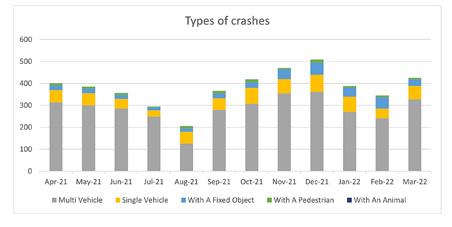
Before the formation of ORS, it took up to five hours to clear a fatal incident.
A smart mobility solution, electronic toll collection (ETC), aims to reduce delays at toll plazas. This can be used throughout the country, where an e-tag is connected to an account and vehicles do not need to stop and physically pay at a toll road. ETC reduces the need for Sanral to add additional toll plazas and lanes, as the current infrastructure is improved by using technology. Vehicleto-infrastructure communication occurs between an e-tag and gantries.
Sanral also offers an app that allows road users to have an easily accessible means of managing their toll/mobility account. It can be used for:
• balance enquiries and a mini statement functionality
• managing the user profile
• managing vehicle data
• real-time top-up to mobility account
• travel information
• parking at selected malls countrywide.
• 4 565 accidents
• 75% involved multiple vehicles
• 15% were single vehicle crashes
• 8% involved a fixed object
• 2% involved pedestrians
• 3 accidents involved animals
26 IMIESA August 2022 ROADS & BRIDGES
Recorded accidents along Sanral’s Gauteng FMS in 2021/22
Siveshni Pillay, project manager: Northern Region , Sanral
The monthly breakdown of the extent of injuries suffered by those involved in crashes
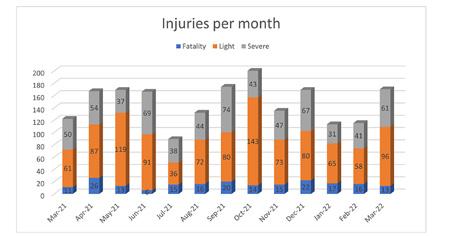
“We have agreements with some of the shopping centres where parking fees are deducted directly from a user’s mobility account, and no physical payments have to be made,” adds Pillay.
Moving from the concept of a toll account to a mobility account
A key focus area for Sanral is to repackage and expand the function of its Transaction Clearing House (TCH) from exclusively clearing e-toll collections to providing a
host of other potential mobility services (such as the already implemented parking payments), as well as vehicle licence renewal payments, fuel payments and driving licence renewals.
One of Sanral’s most exciting projects is Account Based Ticketing (ABT), which is a form of integrated public transport fare management where commuters would have one ticket for all public transport throughout the country. ABT will provide significant cost savings (less cash handling and transaction
costs) and simplify operations. Users will no longer have multiple cards for different public transport systems. If a ticket is lost, it can be replaced as the money is contained in the mobility account. The front-end system or the automated pay collection system will still be implemented by the municipality or transport service provider.
“The most important part of the ABT system is that it’s a step towards mobility as a service. When all public transport is integrated into a single back-office system, the next step would be to get private transport on board and there would be a user-based individual system where technology can assist a person with finding the quickest or cheapest route to a destination. We are far in the process with communicating and collaborating with municipalities, provinces and other role players that provide public transport. Six municipalities have already signed memorandums of understanding,” states Pillay.
Currently, the TCH processes 2.6 million transactions a day, and this is expected to increase to over 17 million transactions per day once ABT is implemented.

CONFERENCE SESSIONS INCLUDE: Raw Materials • Installation • Product Standards • Quality, Design Case Studies • Energy & Environment • Rehabilitation • Certification
Bruce Hollands PVC Pipe Ass, USA
Peter Sejersen TEPPFA, Denmark
Norbert Jansen Borealis Group, Germany
David Fink PPCA & PPI, USA
KEYNOTE SPEAKER: Dr Roelof Botha - Economic Advisor to the Otimum Investment Group - South Africa
Lennert Bakker Soluforce, Netherlands
Albert Vaartjes Rollepaal, Netherlands

Dr Mike Troughton TWI LTD, UK
Norbert Jansen Borealis Group, Germany
Christian Schalich SIKORA AG, Germany
Dolores Herran Molecor, Spain

Alaster Goyns Pipes cc, SA
Grigorios Vigellis Union Pipes Industry LLC, UAE
Mario Messiha Polymer Competence Centre, Austria
Beverley Manikum Sasol, SA
Mike Smart Genesis Consulting, SA
Simon Thomas Simon Thomas Consulting, UK
Victor Pinedo Georg Fischer Piping Systems Inc, Switzerland
Caitlyn Kleingeld Plastic & Chemical Trading, SA
Ilija Radeljic Pipelife, Norway
George Diliyannis Safripol, SA
Jacques van Eck Avesco, SA

Peter Sejersen TEPPFA, Denmark
Ian Venter SAPPMA, SA
Kirtida Bhana Plastics|SA

Ricardo Pascual Aenor, Spain


ROADS & BRIDGES
SPEAKERS AND SPONSORSHIP OPPORTUNITIES AVAILABLE.
BY MEDIA PARTNER MAIN SPONSORS
EXHIBITION,
ORGANISED
of the best 4




Whether its loading, haulage or general site maintenance, access globally acclaimed equipment from four of the world’s leading equipment brands - Bell, JCB, Finlay and Kobelco – all from one point of contact, Bell South Africa
Contact us today to experience premium equipment backed by our leading support network.


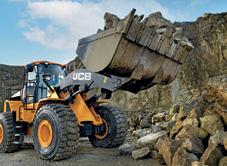
















Bell1672 Strong Reliable Machines Strong Reliable Support Tel: +27 (0)11 928 9700 • E-mail: sales@bellequipment.com www.bellequipment.com
Telehandler
Skidsteer
Wheel Loader Backhoe Loader
Compaction Equipment
Rough Terrain Forklift
B60E 4x4 B45E 4x4 B30E 4x4 B50E B45E B40E B35E B30E B25E B20E SK220XD SK260LC SK380XDLC SK520XDLC SK850LC SK300LC SK135SR
Excavator
Conveyor
Jaw Crusher Cone Crusher Impact Crusher
Incline Screener Heavy Duty Screener Horizontal Screener
Data
Smart mobility collects valuable data –internal data that Sanral can use to inform its infrastructure strategies and external data that can be fed in real time to road users and other stakeholders.
“Our toll gantries provide time and place data and are a critical resource with law enforcement. Sanral receives a number of subpoenas a week for information around crimes from cash-in-transit heists to hijackings and murders,” explains Pillay. She adds that, from a government point of view, data collected will also inform future infrastructure decisions.
However, the management of big data also needs policy decisions around who has access to it and how it can be used.
Research and innovation projects
Sanral has 28 research projects under way in collaboration with universities and industry experts. They are tackling topics around:
• big data management
• technology foresight study
• sensors, IOT, remote sensing and smart transport
• road funding model
• driver behaviour analysis
• advanced bituminous binder
• self-healing asphalt and concrete
• innovative ways to protect assets
• accelerated pavement testing and long-term pavement performance.
An autonomous vehicle test section is considered to plan for future infrastructure needs. Sanral is also investigating electrical vehicle charging facilities and battery exchanges at all rest and service areas, as well as inroad electric vehicle wireless charging.
“We are also investing in research around protecting our assets. Smart solutions are expensive and Sanral’s fibre-optic cable infrastructure is often stolen. We are therefore researching the thermal cameras that can identify any theft-related activity (like people hiding behind bushes) at night,” explains Pillay.
ITS
enhancements
Sanral is in the process of doing an asset refresh. Many of the 250 cameras over a 260 km stretch of road in Gauteng are close to 16 years old. “We are upgrading those cameras and replacing them with newer technology like incident detection technology and artificial intelligence. We are also looking at using our cameras to implement variable speed limits. Next year, we will be implementing ‘Intelligent Weigh In Motion’ to detect overloaded trucks
nationwide, as they place strain on our road infrastructure. We are also very close to finalising a rural emergency services mobile app,” says Pillay.
“Sanral’s leaders have always been forward thinking and have always embraced technology, and that is why we are widely regarded as a global leader in engineering, technology and in mobilising public-private partnerships to keep South Africa’s strategic road infrastructure in excellent shape. Smart mobility is a relatively new buzzword, but Sanral has been implementing smart mobility into its road network since 2005, when the first CCTV cameras were installed,” concludes Pillay.
ROAD NETWORK STATISTICS
• There is 750 000 km of road network in South Africa (surfaced and unsurfaced)
• Of that road network, Sanral runs 22 000 km (2.9%)
• That 2.9% of road network carries 33.1% of all traffic
• That 2.9% of road network carries 70% of all long-distance road freight

Southern African Bitumen Association
ROADS & BRIDGES
At the heart of the plant is a highefficiency counterflow dryer drum with a fully modulating long-nose burner
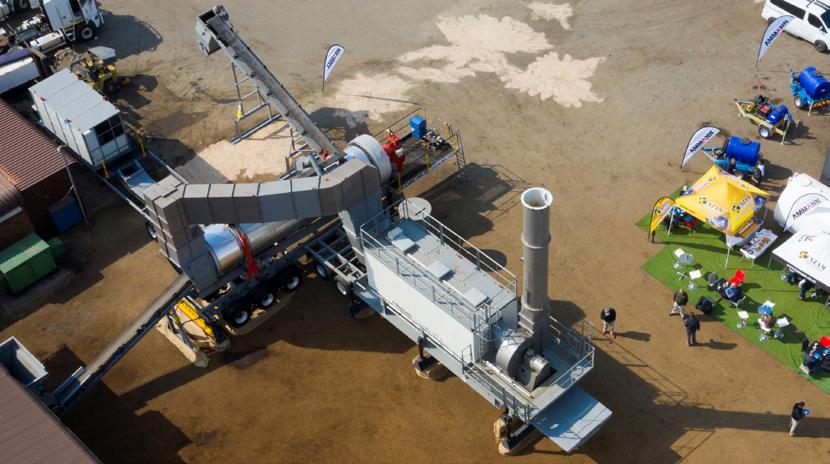
FIRST ROAD-LEGAL COUNTERMIX PLANT for Southern Africa

Ammann – in conjunction with its Southern African dealer, Kenzam Equipment – has developed an innovative trailer system for the Ammann CounterMix 120 asphalt plant, making it road legal and setting a new benchmark for mobility.
Aglobal leader in asphalt solutions for more than 100 years, Ammann meets the market demand for batch and continuous asphalt mixing plants, which can be designed as either static or mobile units, depending on customer requirements.
Within the mix, mobile plants have grown in popularity among road contractors and asphalt suppliers, largely due to their flexibility and suitability for shorter-term contracts where volumes can typically range between 10 000 t to 30 000 t.
In regions like Europe and South America, Ammann mobile plants coming out of the
factory are trailer mounted for legal on-road towing using a truck tractor. However, this is not permissible at present in South Africa in terms of current road legislation without going through a rigorous local homologation process.
“Up until now, mobile asphalt plants in South Africa have been transported from one site to the next using low-bed trailers at significant cost, and we recognised the need for a truly mobile solution,” says Rocco Lehman, general manager for Ammann SA.
Designed for Africa
Leveraging Kenzam Equipment’s in-house mechanical engineering and fabrication
experience, a design was developed based on an Ammann CounterMix 120 plant using currently available road-legal trailer configurations in South Africa. All the trailers are within the bridge formula weight and can legally pass over South African weighbridges.
“We are especially proud of the end result, which has received an overwhelmingly positive response from the industry during our recent customer open days,” says Richard Hurst, director at Kenzam Equipment.
Allied to this innovation is the host of ancillary products manufactured by Kenzam that support Ammann’s aftermarket offering for the CounterMix 120 and other Ammann plants.
30 IMIESA August 2022
The road-legal CounterMix 120 on display during an open day at Kenzam Equipment
BITUMEN & ASPHALT
AMMANN COUNTERMIX 120: KEY SPECIFICATIONS
- Maximum output: 120 t/h
- Number of cold feeders: 4
- Drying drum: Cylindrical, incline counter flow
- Hot mix storage silo: 50 t
- Control system: AS1
- Filter capacity: 31 000 Nm3/h
- Load-out conveyor capacity: 120 t/h
- Gob hopper capacity: 1.5 t

These include drum decanters, emulsion plants, mobile and static bitumen tanks, and mobile laboratories.
The first mobile CounterMix 120 – sold to Zimbabwe-based contractor Exodus & Company – has been configured as four separate trailers to transport the cold feed, drum, filter and control cabin sections. The latter carries most of the loose parts needed to complete the overall final plant assembly.
Modular
“The system is modular, so we can change the setup to suit and this in turn will determine the number of trailers needed. For example, customers can order the basic asphalt plant only, or include allied elements like bitumen tanks and decanters,” Hurst explains.
“The distance between the old and the new setup location will determine how many trucks are required. If it’s a relatively short distance, one truck will do the job, hooking up and moving each individual trailer in turn,” he continues.
Typically, it takes between 14 to 21 days for the relocation and setup of a mobile plant. In the case of the mobile CounterMix 120, this can be achieved without the need for a crane, which is a key advantage when working in remote areas.
Integrated laboratory
The key emphasis of the design is to provide a holistic ‘business on wheels’ for the
client. For this reason, the plant package includes a containerised laboratory, which is an essential requirement for sustainable business operations. Two versions are available: namely, a standard daily testing laboratory and an advanced laboratory, where mix designs can be developed along with specialised testing and reports. Depending on customer requirements, laboratories can also be purpose-built to incorporate other criteria, such as soil and concrete testing.
Standard Ammann warranty and specifications
While the mobile trailer solution is custom built, the CounterMix 120 plant is 100% standard in accordance with Ammann’s OEM specifications.
“This is an important point to emphasise since it means that the plant is backed by Ammann’s international warranty, and proprietary technology,” Lehman explains.
As for all Ammann plants, the CounterMix 120 is operated by the OEM’s proprietary AS1 system, which enables fully automated mix production. System benefits include the use of unlimited recipes, precise burner control, plus full integration of electrically heated bitumen storage tanks. Additionally, historical plant performance data can be used to analyse and enhance performance.
Productivity Partnership for a Lifetime
Ammann has been in the business of developing solutions for customers and industry since its foundation in 1869, which underscores its ‘Productivity Partnership for a Lifetime’ slogan. Alongside its asphalt plant series, this extends to include the Ammann construction equipment range, which includes class-leading products for asphalt compaction and paving.

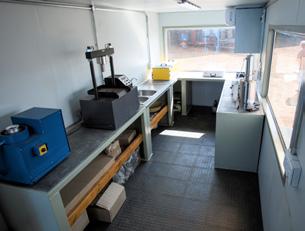
AMMANN COUNTERMIX 120: PERFORMANCE HIGHLIGHTS
- Minimal energy usage
- Reduced VOC content in exhaust gases
- Efficient, environmentally friendly bag filter and pre-separator
- Produces high-quality mix
- Utilises radiation heat from burner flame to aggregates

Ammann has steadily built up its population since entering the Southern African market some 10 years ago for static plants like the ValueTec 180, and mobile units like the ACM 140 Prime. The road-legal, trailermounted CounterMix 120 now adds a further cost-competitive option for the regional construction sector.
“Our customer relationships are based on providing expert advice and service support – something Ammann has been doing successfully for over 153 years,” Lehman concludes.
For more information, visit www.kenzamequipment.co.za


The Ammann CounterMix 120 is designed to produce asphalt products at a lower cost than traditional parallel-flow drum-mix plants

BITUMEN & ASPHALT
An internal view of the containerised laboratory supplied with the CounterMix 120
One of Kenzam Equipment’s core specialisations is the design and fabrication of bitumen decanters
Rougho-4: Road Roughness Measurement Made Smooth
Leaders in data-driven pavement solutions, ARRB Systems Africa ensures cost-effective roughness results in real time with the Roughometer 4 - an advanced intelligence solution for measuring International Roughness Index (IRI) on both paved and unpaved roads. The Roughometer 4 is capable of producing accurate and consistently repeatable IRI outputs, regardless of vehicle type, suspension and passenger loads.
Providing quick road condition assessments, the Roughometer 4 subsequently identifies potentially hazardous road sections, namely: potholes, corrugations, erosion or other ride quality distress aspects. The easy-to-install 2-button wireless distance sensor can be operated by most android phones and tablets.
The wireless operation allows for a 1-person survey, and the MP3 Voice recording feature facilitates increased road safety by ensuring that you never have to take your hands off the steering wheel.




Quick & Easy Road Condition Assessments

Supports projects and pre-defined survey routes in KML format
Data stored on Android device
Co-ordinated location
Mul ti-format reports available including KML and CSV files




Variable roughness measure (IRI, NAASRA or BI) www.arrbsystems.com africa@arrbsystems.com Tel: +27 31 700 2500 Suite 1, Park
Utilises GPS functionality on Android device with Google Maps display
PAVEMENT MANAGEMENT INTELLIGENCE
10 Kyalami Road, Westmead Durban, 3610, South Africa
2000
SATBINDERRR 2022 –Reasons to be there
The Society for Asphalt Technology (SAT) is pulling out all the stops for the upcoming SATBinderrr 2022 conference, taking place between 21 and 22 September at the CSIR International Convention Centre in Pretoria.
Up to 200 delegates are expected to attend the in-person conference, while others will be joining online from South Africa and around the world.
The conference focus areas – Asphalt, Binders, Seals, Pavement Design, Recycling for Flexible Pavements, Chemistry for Roads, and Industry Disruptors – provide a comprehensive overview of not only what’s happening, but what could and potentially should happen within the industry.
“We need to look hard at the future and this is a conference that will allow us to do that. Our sustainability is not about today, but about tomorrow,” says Herman Marais, president, SAT.
“Fresh ideas and out-of-the-box thinking from our young, passionate presenters are balanced by the wisdom of industry stalwarts who have dozens of years of experience in South African and global asphalt technology,” Marais continues. He urges those not yet convinced to visit the Society for Asphalt Technology website to view all the presentation topics, abstracts and presenters.
Masterclasses
At the conference, delegates will have exclusive access to masterclasses presented by three of South Africa’s top asphalt and bitumen experts.
Gerrie van Zyl, director of Mycube Asset Management Systems, will share a threehour slot on how to minimise the risk of poor performance in seal work. His content is based on the knowledge of experienced practitioners and interrogation of a younger generation, more than 30 forensic investigations into premature failure, as well as global research.
Eddie Bond, technical executive at AECI Specialty Chemicals, will host a masterclass on adhesion promoters, covering the chemistry of each class of AP or anti-stripping agent, how they bond on aggregate surfaces, and applications.
Johan Muller, operational executive at SRT, will lead a third session covering binders from evolution to specifications to alternative technologies.
Keynote speaker
Audrey Copeland, keynote speaker at SATBinderrr 2022, is one of the leading
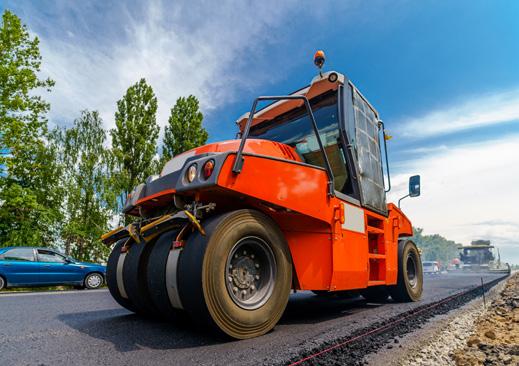


Audrey Copeland, keynote speaker at SATBinderrr 2022, is one of the leading asphalt professionals in the USA and globally
asphalt professionals in the USA and globally. Copeland was appointed as president and CEO of the National Asphalt Pavement Association (NAPA) in 2019. Previously, she served for seven years as NAPA’s vice president: Engineering, Research and Technology.
Copeland has a PhD in Civil Engineering from Vanderbilt University and is a registered engineer in the Commonwealth of Virginia and State of Maryland.
Sponsors
As testimony to the importance of this event, SATBinderrr 2022 has secured no fewer than 14 sponsors. These are:
• AECI Much Asphalt : Gold Sponsor
• KBK Engineers : Silver Sponsor
• Specialised Road Technologies : Silver Sponsor
• Specialised Testing Laboratory : Silver Sponsor
• Anton Paar : Bronze Sponsor
• Liesen : Bronze Sponsor
• Roadlab : Bronze Sponsor
• AECI Speciality Chemicals : Chemistry for Roads Focus Area Sponsor
• B2SQUARE : Industry Disruptors Focus Area Sponsor
• BVi : Recycling for Flexible Pavements
Focus Area Sponsor
• Colas : Seals Focus Area Sponsor
• National Asphalt : Asphalt Focus Area Sponsor
• ROMH Consulting : Pavement Design
Focus Area Sponsor
• Tosas : Binders Focus Area Sponsor. Comments Gold Sponsor AECI Much Asphalt: “AECI Much Asphalt believes the value of SATBinderrr lies in providing a platform for all the sectors of the bitumen industry to share ideas and best practice. Critically, it also gives a voice to the inexperienced practitioners to communicate with experienced knowledge and world-renowned experts.”
IMIESA August 2022 33 BITUMEN & ASPHALT
FLEXIBLE AND


ADAPTIVE
to a changing world
The Southern African Bitumen Association (Sabita) has been championing design and product innovation in asphalt pavement construction since 1979. IMIESA speaks to Phil Hendricks, Sabita’s new CEO, who takes over the reins from Saied Solomons following his recent retirement.
How has your passion for roads and transportation engineering evolved during your career?
PH While I always had a fascination for engineering from a young age – fuelled by hours of Meccano set construction – my passion for the roads and transportation discipline was really ignited during my time lecturing at the Peninsula Technikon in Cape Town. I spent many hours in the mid1980s engaging with former Sabita CEO Piet Myburgh and technical director Rob Vos in the establishment of the asphalt laboratory at the Technikon, plus the extensive moderation of the various asphalt and material courses.
Later, I was fortunate to continue studies at the University of California, Berkeley, where I also worked as a research assistant under Professor Carl Monismith on the Strategic Highway Research Program (SHRP), which started in 1987 when the US Congress initiated the applied research initiative to improve the performance and safety of their national highway system.
Once back in South Africa, I moved to Pretoria and started working at the Division of Roads and Transport Technology of the CSIR, where the decades-long research exchange programme between Dynatest, the CSIR, University of California, Berkeley and later Davis and the California Department of Transport was about to be announced.
After 16 years within the research environment, I was once again able to fuel the passion when I joined Africon in
the consulting engineering environment. At the time, Africon was in the process of becoming part of a global consolidation of three entities. Over the ensuing years, I held several positions at global and local levels within the roads and transportation field.
What are some of the key lessons learnt?
Let me touch on two that come to mind. The first lesson learnt is that by its very nature the engineering industry is honed through generations of excellence in mentoring and development. Mentors have played an invaluable role in my career, and their impact cannot be underestimated.
The second lesson is that our road engineering expertise has always been outstanding. South Africans can feel very proud of the technologies developed locally and exported over time to the rest of the world. This has been achieved through focused research and collaboration between industry stakeholders within the private and public sector.
As the new CEO, what are your objectives?
It’s important for Sabita to remain flexible and adaptive to political, economic and technological changes as it continues to lead the bituminous roads industry, delivering value for its members.
In future years, I do not expect major changes in the pivotal elements of Sabita’s strategy but expect to see increases in
the efforts related to the promotion of sustainable practices for the construction and maintenance of our roads, and the promotion of sustainable human resources for the development of a proficient profession and a productive, skilled and competent work force.
What are some of Sabita’s key achievements to date?
Sabita has been in existence for 43 years, with an impressive record of key achievements for its members over the years. Examples include:
• The evolution of the four-yearly Conference on Asphalt Pavements for Southern Africa (CAPSA) as an internationally reputable event, cognisant of the latest sociopolitical, environmental and technological developments, for local and international transport professionals.
• Continued research and development endeavours initiated following the launch of the Asphalt Research Strategy Task Force (Arest). This has seen the outputs of research driven into practice with the development of research papers and the publication of technical manuals and guidelines. These technical manuals have become standard reference documents for the industry and, over the years, a host of new products have been introduced, including LAMBS (large aggregate mixes for bases) to provide a cost-effective solution for increased traffic loadings, GEMS (granular emulsion
34 IMIESA August 2022
BITUMEN & ASPHALT
Phil Hendricks, CEO, Sabita
mixes) to improve the structural strength characteristics of emulsion treated granular materials, and recently the French technology EME (enrobé à module élevé) to evaluate the use of highmodulus asphalt in pavements on highly trafficked routes.
• HSE activities with Sabita inaugurating its Centre for Occupational Safety, Health and Environmental Conservation (Coshec) in 2002. This oversaw the development and implementation of self-regulation policies such as safe working practices and bitumen safety training. Sabita later launched its HSE Charter, which promoted compulsory selfregulating compliance of all members, with global standards of safe working practices aligned with local statutory requirements and global best practice.
• The introduction of performance grade (PG) binder specifications into South Africa due to changing traffic volumes and traffic loading. The previous empirical bitumen increasingly failed to relate test results to pavement performance; and fundamental, visco-elastic and damage characterisation methods have been adopted.
How has the market responded to the launch of the Roads Maintenance Forum (RMF)?
The inaugural RMF event was held virtually on 7 April 2022 to coincide with International Road Maintenance Day, and was presented as a joint initiative between CESA, IMESA, SARF, SAT, SAFCEC, Sanral and Sabita. The market reacted extremely positively, with 331 attendees from across the broader roads industry, which presented the ideal platform for the exchange of information and technologies. Delegates included urban, rural, national and provincial authorities, as well as established and emerging consultants and contractors.
Future topics proposed for subsequent RMF meetings include:
• the quality and standard of maintenance work and proactive resurfacing programmes
• education on the importance of maintenance and the financial management of maintenance contracts
• use of digital technologies for remote monitoring.
The next RMF event, which will also be held online, takes place on 5 October 2022.
Are South Africa’s bitumen and asphalt standards in line with international best practice?
Most definitely – the linkages that Sabita and other entities in South Africa have with global research institutions and associations remain vital in staying abreast of the latest developments. These developments are typically then evaluated and improved on for the local environment and incorporated into new or updated best practice guidelines.
The exchange of information regionally and globally is critical, and Sabita is a member of several bituminous associations. These include GAPA (Global Asphalt Pavement Alliance), which, in addition to South Africa, represents associations based in Australia, Europe, Japan, the US, New Zealand and Mexico.
Local research efforts at the CSIR and the universities – particularly those that are Sanral funded – must also be acknowledged in keeping South Africa’s standards at the highest levels.
What are the major constraints and opportunities for South Africa’s roads sector?
Two major constraints include the bitumen supply and industry capacity situations.
Only one of South Africa’s four crude oil petroleum refineries, namely Natref (Sasol and Total) in Sasolburg is currently in production to serve the bitumen demand. The imports will continue to grow, with major impacts on the bitumen industry, including the need for increased inventory holding, the establishment of port infrastructure enhancements, concerns over the quality variance of the imported bitumen, and the appropriate price recovery mechanisms and price fluctuations.
Many of the role players in the industry are struggling and we are seeing shrinking industry capacity due to the low level of contracts. The human capital and skills shortage is also being influenced by the maturing of the experienced skillsets and continued emigration.
There are many opportunities for South Africa’s roads sector, and this is well documented in the country’s infrastructure policy, its renewal plan, and the National Infrastructure Plan for 2050. The various road authorities’ plans point to significantly higher expenditure on road maintenance
and repairs to reduce the road maintenance backlog. All of this will be dependent on the authorities procuring the work timeously and without disruption.
How can Sabita help to make the
difference?
Sabita can and will continue to help in making a difference in the industry as it has for the past 43 years. However, I strongly feel that we will need to coordinate many of our industry efforts even better than we have before to significantly move the dial due to scarce and shrinking resources.
Sabita will be driving more effective and efficient collaboration across the industry and looks forward to ensuring that it plays a meaningful role in promoting road construction and maintenance as a key catalyst for economic revival and growth.
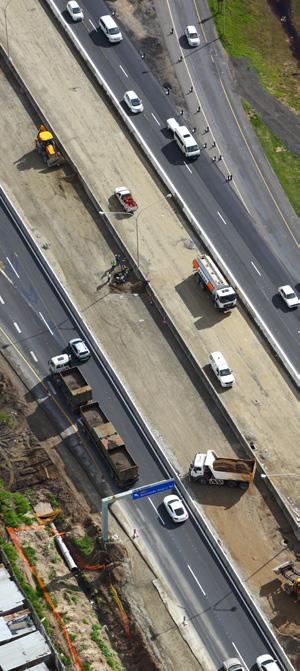
BITUMEN & ASPHALT

AN ENGINEERED RESPONSE TO POTHOLE REPAIRS
As with any structure, flexible pavements deliver the best return on investment over their designed lifespan when routinely maintained. Alastair Currie speaks to Johan Hattingh, founding director at PHB Consulting Engineers, about the occurrence of potholes along the way, their causes and repair interventions.
Even the best constructed pavements locally and globally will have some element of inherent failure due to ensuing factors that include geology, roadbed reactions and moisture under the road. At times, these and other causes result in the formation of potholes that need immediate repair. However, their occurrence on new infrastructure should be isolated incidences.
“The starting point is to ensure that roads authorities have an up-to-date asset management system, which includes current data on the health of their road network,” Hattingh explains.
“The ultimate goal is to optimise utilisation through scheduled preventative maintenance programmes according to accepted civil engineering design codes (like TRH4), which include resealing roads at regular intervals. This helps to prevent, or at least reduce, the occurrence and prevalence of potholes as the road ages,” he continues.
Hattingh stresses that getting the basics right is the foundation for any maintenance strategy. If one pothole forms within a 200 m section, then the situation is not a major concern, but it still requires investigation and remediation. However, if a whole road starts to pothole, then it’s time for a rebuild, since any money spent on patching will be a recurring, expensive and pointless exercise.
“Any emergency patch has a very short lifetime,” he explains. “That’s fine if it’s
an immediate safety issue, and where works need to be opened to traffic as soon as possible, but a lasting and effective repair still needs to be done.”
Determining the causes of failure
Repairing potholes requires an expert understanding. This will determine the underlying cause of the failure, examples of which include deformation, binder properties, ravelling, crack activity, pumping and poor drainage.
“Each distress type tells a story. For example, signs of deformation usually indicate that the problem is deep down; sharp rutting – typically at an intersection – most probably indicates an issue with the asphalt binder properties; while ravelling – or failing from the top – is generally due to ageing,” says Hattingh.
Once an analysis has been completed, this then forms the basis for the intervention, which includes determining the choice of patching materials, the thickness of the asphalt repair, reinstatement of drainage, how long the repair is expected to last, plus any follow-up activities required.
Like for like
“The fundamental principle is that the patching material must be compatible with the existing pavement. This means that a granular base must be matched with granular material of similar properties; a macadam base with macadam material; and a cemented base with cemented material,” Hattingh explains.
Hattingh is a recognised expert on asphalt materials. He founded the Macadam Franchise Company in 1999 and completed his master’s degree in 2012 based on the research and development of slurry-bound macadam (SBM) technology.
The remarkable durability of macadam roads has been well proven over the years since the pioneering development of this technology by Scottish engineer John McAdam in around 1820.
“The whole of Gauteng’s West Rand up until the 1970s was built using water-bound macadam materials, while roads in central business districts like Johannesburg have been constructed with penetration macadam. Now, these roads are at the end of their life. Without a full rebuild option, they can be extended for now with SBM patching. No other alternative asphalt patch material will work,” Hattingh explains. He adds that the most common form of macadam failure is ravelling. The layer works condition tends to be sound due to the excellent stone interlock.
Basic construction techniques
Even with the optimum material selected, a patch can still fail if the incorrect repair technique is employed. Some fundamental points noted by Hattingh include:
• Limiting the depth of the sawcut joint to 5 mm. A common error is to cut through the asphalt using a diamond cutting blade. This tends to smear the bitumen and close up the voids in the asphalt. Since asphalt is naturally permeable, this needs to be avoided at all costs to prevent moisture entrapment.
The softening point of bitumen is between 60˚C to 80˚C, and


36 IMIESA A ugust 2022 BITUMEN & ASPHALT
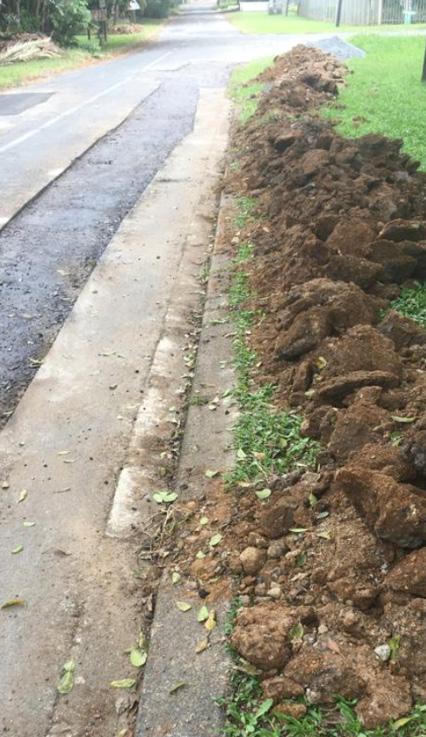
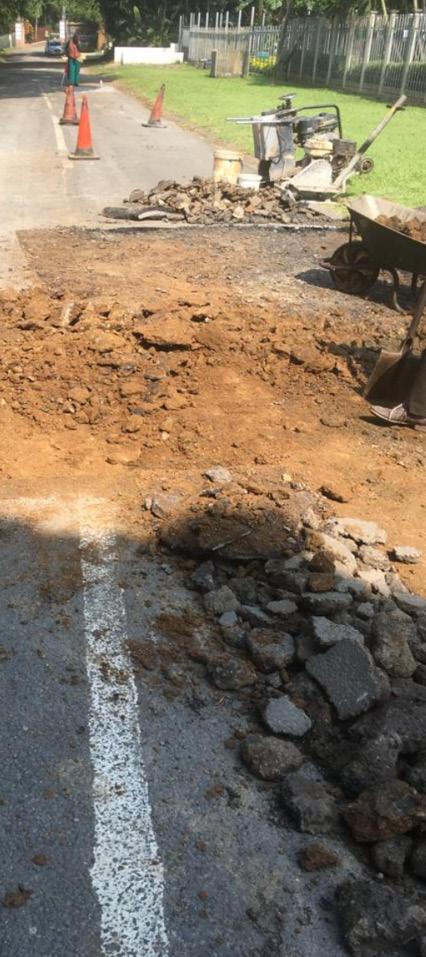
the road temperature is approximately double the ambient temperature. If moisture is trapped in the asphalt layer, the bitumen starts to soften and strip from the road stone on very hot days.
• Avoiding jointing in the wheel tracks. The recommended approach is to vary the joints either between the wheel tracks, or between lanes.
• Avoiding vertical excavation walls. The recommended approach is to step or incline the excavation.
• Avoiding ‘dam wall’ formation in the layer works.
“The layer works of a road can be compared to a laminated beam. The more uniform the road, the better its life. When you break into it, you break into the structural system, potentially aggravating the situation if you don’t understand the root cause,” Hattingh continues.
For example, incorrect patch techniques can change the natural flow of moisture in the pavement, with the potential of creating a reservoir under the wheel tracks. Patches can also change the reaction of a vehicle’s suspension, resulting in poor riding quality and the build-up of stresses in the pavement, which accelerate the formation of new potholes. “It’s comparable to a hammering effect, compounded by a pumping effect where there are moisture concentrations,” says Hattingh.
Life-cycle maintenance and rebuilds
It's a well-known fact in industry that it can cost around 10 times more to rebuild a road than to maintain it. Leading authorities like Sanral understand this, setting the benchmark for asset management and routine maintenance on its tolled and non-tolled national routes, responding to and fixing reported potholes within 48 hours.
However, this is not the case for a growing proportion of secondary provincial and municipal roads, many of which
have severely deteriorated. A recent development in response is the launch in August 2022 of Operation Vala Zonke by South Africa’s Minister of Transport. This is a national campaign to tackle the pothole pandemic, which will be spearhead by Sanral as it engages with provincial and municipal roads entities to map the way forward. The campaign will include the introduction of a pothole reporting app, which will operate in conjunction with an existing Sanral app.
“This is very positive step to stem the current situation. It also provides a great opportunity to train local roads authorities in the right repair techniques and to reinforce the need for an expert determination by suitably experienced engineers,” adds Hattingh.
“However, the best approach going froward is to stick to maintenance plans and steer away from temporary emergency patching, which wastes funds that can be better spent on longerterm in situ recycling and resurfacing operations,” Hattingh concludes.

 Segregation of G1 patching material creating a permeable joint
An example of well-intended, but poorly executed, pothole patching. Key errors to note are the incorrect choice of base material, as well as poor joint placement
Segregation of G1 patching material creating a permeable joint
An example of well-intended, but poorly executed, pothole patching. Key errors to note are the incorrect choice of base material, as well as poor joint placement
IMIESA August 20 22 37 BITUMEN & ASPHALT
Poor joint placement

Public transport models THAT WORK
Integrated transport systems are the future of smart mobility, with public transport central to current and future spatial planning. Yusry Frizlar, technical executive: Business Development at GIBB, shares his views with reference to past and current projects that include bus rapid transit (BRT) networks. By
Alastair Currie
GIBB has a well-established track record for the design and construction management of complex transportation engineering projects across South Africa and in Africa, with a strong focus on rail, roads and transport engineering.
A milestone project includes GIBB’s involvement on the Gautrain Rapid Rail Link (GRRL) Project from inception in 2000 (until 2016) as a member of the Province Support Team. At the time, the GRRL was part of the Gauteng Provincial Government’s Blue IQ initiative.
Within the Tshwane and Ekurhuleni regions, GIBB was also responsible for delivering a range of services for the GRRL. The company actively participated in the preparation of preliminary and feasibility studies, passenger and revenue forecasting, preparation of bid documents, adjudication of bids, as well as negotiations with the preferred bidder, leading to the appointment of a concessionaire. GIBB (and its consortium partners) reviewed the concessionaire’s designs and monitored construction of the GRRL.
Another core aspect of the GRRL development was GIBB’s responsibility for the design and
construction supervision of the approximately 15 km tunnel sections along the route, including three underground stations.
“Our involvement on the Gautrain project enabled us to apply our full suite of skills to facilitate a highly successful commuter system for Gauteng,” says Frizlar. “The key to these projects is getting the commercial model right so that there’s a realistic payback for the concessionaires and an affordable transport solution for the public segment serviced.”
Provincial and national rail plans
During 2006/07, GIBB assisted the Passenger Rail Agency of South Africa (Prasa) with the development of the regional rail plan for the Eastern and Western Cape, and was part of a consortium that produced the national rail plan. These were high-level plans looking at future scenarios based on ongoing investment and the expectation of increasing demand.
“The dramatic collapse of passenger rail in recent years, with a drop in passengers of up to 90% (for a variety of reasons) is quite tragic. GIBB will continue to be available to assist Prasa in restoring and enhancing the passenger rail system,” Frizlar continues.

Yusry Frizlar, technical executive: Business Development at GIBB
From around 2014, public sector investment in rail – as well as infrastructure in general – started to decline sharply, with operational challenges forcing many businesses to switch to truck haulage to meet their logistics requirements. In addition to rising transportation costs, this has also led to increased wear and tear on South Africa’s roads.
“From a socio-economic standpoint, a renewed focus on enhancing the full value chain of freight rail makes financial sense, as does the revitalisation of passenger rail services,” says Frizlar.
Transnet’s recent initiative in offering branch lines to private operators is a step in the right direction. However, it does take time for private industry to develop the capacity to fully commercialise these opportunities.
Urban commuter rail systems within municipalities
South Africa’s National Land Transport Act (No. 5 of 2009) makes provision for metropolitan municipalities – with the skills and capacity – to progressively assume responsibility for the management and operation of commuter rail networks. Clearly, there are capex, opex and maintenance cost
38 IMIESA August 2022 TRANSPORTATION ENGINEERING
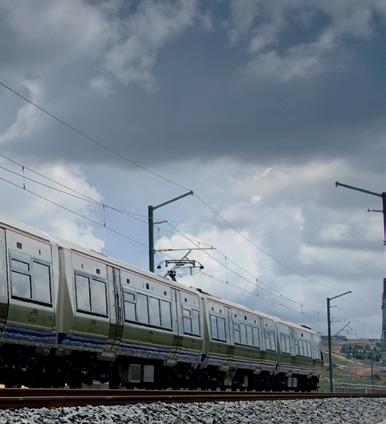
implications. At present, these are Prasa’s responsibility. Metros like the City of Cape Town are tentatively exploring the opportunity and financial viability of taking on commuter rail as part of an integrated transportation solution with the other modes operating in the metro. Cape Town’s feasibility study commenced in July 2022 and will consider the risks and opportunities.
“Within the suburban environment, rail is still viewed as the backbone of public transport systems. For example, when Cape Town embarked on its MyCiti BRT plan, this was intended from inception to complement rather than compete with rail. In Cape Town, current and future BRT lines have also been mapped out in areas where rail is not present or dominant,” Frizlar continues.
GIBB has the distinction of designing the first BRT system in South Africa, which was constructed ahead of the 2010 FIFA World Cup. This route connects Soweto with Johannesburg’s CBD, with BRT stations along the way serving the Nasrec showground and FNB Stadium.
BRT benchmarks
In the run-up to the 2010 FIFA event, Frizlar gained first-hand experience of high-performing BRT systems in South America, including in Ecuador (Quito), Colombia (Bogotá and Perreira) and Brazil (Curitiba and São Paulo).
South Africa’s National Department of Transport had decided to fund BRT projects in South African metros from around 2007. By 2018, South Africa’s public sector had invested some R14 billion on BRT networks nationally.
“An immediate observation is that South Africa’s urban environments have far lower population densification levels, which impact on the viability of public transport systems, and dramatically increase the operational subsidies required by public transport. Our historical apartheid spatial planning has resulted in residential zones and dormitory townships being spread out over extended distances from commercial nodes,” Frizlar explains. Johannesburg, for example, has an estimated population density of 2 700 people/km2. Bogotá, Colombia’s capital city, has at least five times that density, which assists in shorter travelling distances, lower operating subsidies, and
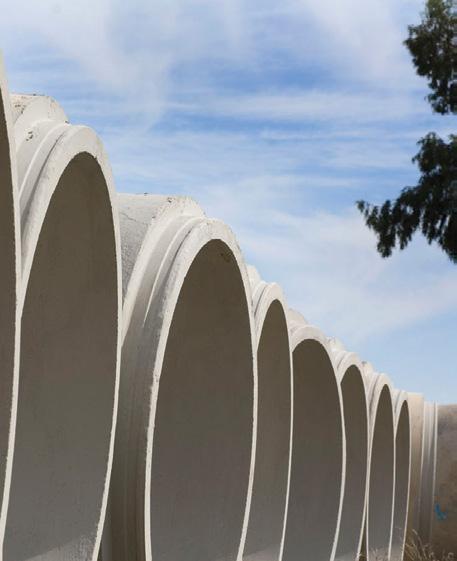

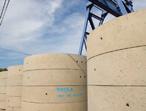


A STRONG FOUNDATION FOR INFRASTRUCTURE SUCCESS
ROCLA is South Africa’s leading manufacturer of pre-cast concrete products.
Surpassing 100 years of product excellence.
• Pipes
• Culverts Manholes

for our nationwide branches

Visit
www.rocla.co.za
us on
YOUR DEDICATION LEADS TO NEW BEGINNINGS AND OPPORTUNITIES.
TOGETHER, WE MAKE IT POSSIBLE.



Together, we make it possible. Ask for AfriSam.
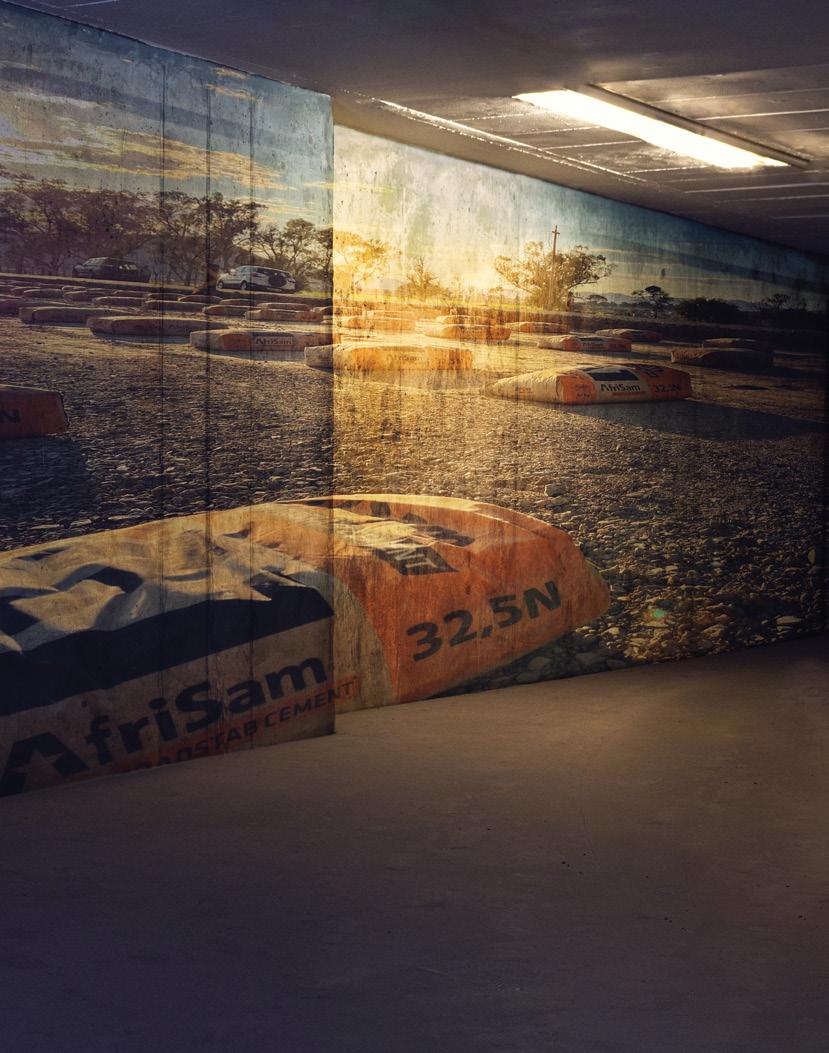

www.afrisam.com Creating Concrete Possibilities
1012349
is a high quality cement, specifically engineered and designed to reduce plasticity and enhance the strength and stability of road-based materials. In your hands, our advanced formulation ensures your effort is time well-spent.
efficient utilisation of the bus fleet.
Average BRT trip lengths in Bogotá are around 12 km, which means faster turnaround times.
In comparison, the average trip length in Johannesburg on the current BRT network (1A, 1B and 1C routes) is approximately 27 km.
“Distance is important but not the only factor. The key to any public transport mode is optimum utilisation – i.e. the maximum number of passengers on any trip during peak and off-peak periods,” says Frizlar.
Cape Town BRT

At the start of Cape Town’s BRT implementation, GIBB was appointed as lead consultant and project coordinator for the Inner City Integrated Rapid Transit infrastructure project forming part of the MyCiti bus network.
GIBB’s responsibilities included the planning, design, procurement and implementation of inner-city routes, bus depots, plus open and closed stations.
Over the past five years, GIBB has been involved on Cape Town’s Phase IIA BRT route, which runs from Khayelitsha and Mitchells Plain towards the Southern Suburbs. GIBB’s contract was recently renewed for a further seven years, with responsibility for detail design, tender documentation and construction monitoring on five construction contracts that will be advertised in due course.
GIBB has also assisted the City with BRT operational support, as well as input on
business planning as a subconsultant. “While it’s common worldwide for public transport systems to be subsidised, sustainable revenue streams still need to be achieved. Business planning therefore has a direct bearing on the most optimal transportation design,” Frizlar explains.
A case in point is Cape Town’s decision to adopt a hybrid model on Phase II, where the metro’s costs will be contained by promoting the use of minibus taxis on feeder routes tying in with BRT trunk lines.
Traffic management
The advent of the Fourth Industrial Revolution and the internet of things has helped to revolutionise intelligent public transport systems internationally. Examples include the use of smart city debit cards that residents can use for all municipal transactions ranging from public transport
(across modes) and parking to utility payments.
The cloud-based data generated from these card activities then provides invaluable statistical information on travel behaviour patterns that help to refine transport models. Examples would include updated timetables, and more buses at set times on specific routes.
City planners will also have to factor in new entrants to the public transport market, including the growth of the e-hailing segment in estimating future bus demand.
“There are no quick fixes for public transport in South Africa, but we continue to learn and benchmark our systems against leading countries globally. In the short to medium term, we need multifunctional transport corridors serving mixed-use developments that enable more effective land-use and reduced travelling times and distances for commuters,” adds Frizlar.
Densification projects around existing rail nodes are among the ways to achieve quicker wins. Past examples include mixeduse developments in Rosebank tying in to the underground Gautrain station. A current example is the major revamp under way at Cape Town railway station. This R1 billion plus mixed-use development includes a 20-storey student accommodation hub and retail space.
“We need to speed up these multipurpose projects around large rail stations to make public transport more viable, densify our cities, aid economic developments and improve the quality of life for all,” Frizlar concludes.

TRANS PORTATION ENGINEERING
IMIESA August 2022 41

The benefits of reinforcing slopes WITH GREEN TERRAMESH
Green Terramesh is an environmentally friendly modular system used for soil reinforcement in mechanically stabilised earth slopes and embankments. Its purpose is to prevent erosion, provide soil reinforcement and assist with slope stability – all while blending in with the natural surroundings.
By Thivaska Padayachee & Vernita Govender*
The concept was initially introduced in Malaysia in the late 1970s when a structure was erected to support a road embankment in a highly constrained area. It was composed of a vertical ‘skin’ of rock-filled gabion mesh units that were fastened to the structural fill of the embankment with horizontal steel strips. From there, Maccaferri’s Green Terramesh System (GTMS) continued to evolve to meet a range of modern day engineered solutions. During construction, Terramesh units are placed in horizontal layers during the filling and compaction of a structural embankment. The main unit is fabricated from continuous, heavily galvanised and PVC coated steel wire, which is woven into a double-twisted hexagonal mesh configuration. Attached to the inside facing is a geosynthetic or biodegradable erosion control blanket (ECB), a welded steel panel, and two steel brackets preformed to a 70-, 60- or 45-degree slope angle (or inclined front face) to enhance vegetative growth.
The ECB retains the backfill soil and permits a vegetative cover to establish rapidly. It may consist of a permanent geosynthetic threedimensional geomat (hydraulic application), or a biodegradable 100% coconut fibre biomat (dry application).
The welded steel panel placed behind the ECB adds strength and provides support to the facing, while holding the blanket in place during construction. In turn, the top section of the main wire mesh is used to anchor and connect the unit to the one above via the specific lacing technique.
Applications
GTMS can be used in various applications, such as: an alternative to near-vertical retaining structures; protection in river, stream banks and shoreline situations; and development projects on steepened landscape sites.
As an environmentally engineered solution, GTMS is ideal where a greened aesthetic is required in addition to immediate and
long-term protection from surface erosion and geotechnical failures. Installing a continuous series of mesh panels ensures rigidity of the front face.
GTMS units are supplied cut to specified measurements, as determined by the design. Therefore, no cutting is required on-site.
Vegetation and drainage
Various vegetation techniques can be used with this system, including live stakes, rooted plants, seed and hydroseeding. These vegetation techniques are incorporated after the installation of the structure. The best approach is to match the planted vegetation with naturally occurring plants in the area. This will ensure that the final landscaped result is indigenous and water wise. Plus, there’s a much greater certainty that the new vegetation will take hold.
As with any retaining system, adequate drainage at the rear of the reinforcement should be installed where seepage of surface water is a factor. It is also recommended to step the units back 100 mm to 150 mm to reduce the velocity of the water flowing down the front face.
Design software for Green Terramesh
Since the system is a mechanically stabilised earth structure, it is important to verify the stability of the slope prior to construction. To determine this, MacStars W software is one of Maccaferri’s most popular programs. It is mainly used to design and check the stability of reinforced and unreinforced structures. The designs generated are mainly based on the shear strength of the soil below and
M4 INFRASTRUCTURE REINSTATEMENT WITH GREEN TERRAMESH
The Department of Transport together with eThekwini Municipality faced a major challenge when periodic heavy rainfall, coupled with a burst underground concrete pipeline, resulted in a major embankment failure and partial collapse of a section of the M4 highway.

Interventions included a new HDPE underground stormwater pipe, while the upper and lower embankment slopes were reinforced with Green Terramesh in conjunction with Maccaferri’s ParaGrid geogrid reinforcing solution.
Reinstatement in progress on a section of the M4

Vegetation starting to take hold on the completed GTMS installation
GEOTECHNICAL
Benefits Features
Structurally sound Computer software and technical support to assist in the design of structures ensure a structurally sound engineered solution. Excellent connection mechanisms eliminate the risk of failure between the reinforcement and the front face
In situ materials Besides the 0.3 m deep wedge behind the front face, in situ material can be used to backfill the structure
Sand-only solution Useful when soil is the only material available for construction
Immediate, long-term erosion protection
GTMS itself gives immediate structural stability, which grows stronger with time as the vegetation is established
Easily greened More conducive to greening due to the sloped front face
Ecological protection Provides aquatic, riparian cover and wildlife habitat value
Traps sediment Helps to slow water velocities near banks and trap sediment
Durability Galfan and PVC coated wire products ensure high performance and durability
Versatility Individual units allow for easy design and construction of a sitespecific solution
Easy to install A straightforward system of combining individual units to form a reinforced structure. Unskilled staff can quickly and efficiently install units on-site, under skilled supervision
Cost-effective In situ construction minimises the cost associated with using imported materials. Furthermore, the modularity of the unit makes the construction time cost-effective, while the durability gives an outstanding life-cycle cost benefit
Environmentally friendly Structures can be naturally integrated with the surrounding environment by using in situ materials combined with various bioengineering techniques. Plant life can be incorporated into the design to accelerate vegetation
Flexibility The structure’s flexibility allows its use even in poor soils, as it can adapt to foundation settlements with moderate deformations


surrounding the structure in terms of its frictional angle, weight and cohesion parameters. The software also enables the user to model the exact strata of the area with and without a water table in the case of a river or heavy rainfall area. There are many load configurations that can be used for the different load cases, along with a wide variety of reinforcing elements to select from and design with.
The MacStars W software produces designs in accordance with the guidelines prescribed in the BS Code – ‘British standard codes of practice for reinforced soils and other fills’. The design considers both the ultimate and serviceability limit state principles and runs the design analysis using the coherent gravity method.
Internal and external stability
It is important to note that there are key rules that need to be followed when determining the structure’s minimum embedment depth and reinforcement lengths. For the structure to be rendered stable, the MacStars W software analyses the internal and external stability. This includes rupture of the reinforcements within the structure, and any sliding, overturning and bearing pressures exerted on to the structure and the foundation.
Slopes and embankments often require additional soil reinforcement for extra strength. This is most common in cases where a steeper slope is desired or in the reconstruction of a failed slope. Flexible reinforcement enables the structure to rest at a much steeper angle than its natural form and provides stability to the structure by transferring the destabilising forces from the active zone to the resistant zone with an adequate bond tensile stiffness.
Conclusion
Green Terramesh has proven to be a costeffective and popular solution worldwide and has recently been widely adopted in South Africa to reinstate failed embankments and slopes washed away during recent floods. For the rehabilitation of vegetated slopes and embankments, GTMS provides lasting stability with the inclusion of high-strength geosynthetic grid reinforcement. Vegetating the front face serves two key purposes: the first is short-term protection, while the second is to achieve that legendary Green Terramesh effect.
*Thivaska Padayachee and Vernita Govender are graduate civil engineers at Maccaferri Africa.
IMIESA August 2022 43 GEOTECHNICAL
Top tail
Coconut fibre blanket
Welded steel panel
Steel bracket Anchor
Components of a Green Terramesh system economical operation
Representation of a Green Terramesh system
Why pipe jacking is a
NICHE PROFESSION
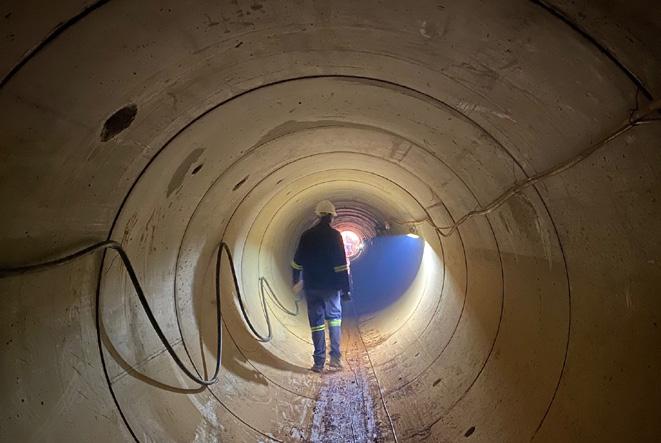
A walkthrough inspection of a completed tunnel section

Pipe jacking – which is a technique used to tunnel medium to large services under roads, railways and other infrastructure
– is a highly specialised field requiring expert application knowledge to yield optimal results, says Byron Field, director, BLOC Contractors.
On one of BLOC’s recent pipe jacking projects, the company completed an approximately 24-month contract working as a subcontractor on an extensive Rand Water maintenance and upgrade programme within the greater Johannesburg area.
BLOC’s scope entailed the execution of specialist subcontract works on key sections of Rand Water’s S4 and H47 pipelines. This comprised a total of 822 m of large-diameter pipe jacking over 15 No. crossings. Sizes were predominantly 2 800 mm diameter reinforced concrete pipe sleeves, with some smaller at 2 160 mm.
“These underground sleeves were necessary so that Rand Water could install their massive steel pipelines – some of which are up to 2 m in diameter – underneath critical infrastructure such as roads, railway lines and existing pipelines without having to disrupt the operations of these services,” Field explains.
BLOC is well positioned to handle largediameter pipes and culverts – where sections
can weigh up to 10 tonnes – thanks to its fleet of heavy-duty gantries, which are uniquely designed to handle such large elements. Once the main pipeline contractor had installed the steel pipes, BLOC’s team went back to grout them in place to eliminate any voids.
“BLOC mobilised six teams to the various contract sites, some of whom worked day and night to achieve the tight deadlines,” Field continues, adding that ground conditions varied from waterlogged collapsible sands to very hard rock exceeding 180 MPa.
Due to the sensitive nature of various overhead structures, especially rail infrastructure, conventional blasting of hard rock zones was not always permissible during pipe jacking operations. Where these conditions were encountered, BLOC employed a combination of proprietary lowvibration blasting (suited to confined space work), as well as specialised hydraulic rock splitters.
Responding to variable ground conditions
On any pipe jacking programme, one of the major threats is a potential catastrophic failure of the tunnel front face. That needs to be avoided at all costs.
“To illustrate the point, during the pipe jacking programme for the 2 800 mm sleeves on the Rand Water project, the excavated front face of the tunnel measured some 6.5 m2. This front face must be kept constantly under control. When tunnelling through rock, that’s much less of an issue, but where collapsible soils are encountered – together with high water tables –it’s a different story altogether,” Field explains.
“This is where the proficiency and experience of the pipe jacking specialist is crucial to prevent potential settlement of aboveground structures like buildings, roads and rail. Clearly, that’s the whole purpose of employing this trenchless technology in the first place – to optimise time and cost efficiencies compared to open-trench options – but perfecting the approach is what sets the benchmark locally and globally,” Field continues.
44 IMIESA August 2022 GEOTECHNICAL
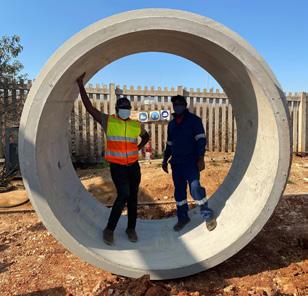
Method statement
The method statement starts with a determination of the jacking capacity required, based on the length, diameter and geology. As part of the temporary works, a thrust wall is then constructed (anchored into the ground) in the launch pit to accommodate the horizontal jacking loads. “Getting these temporary works calculations correct is essential for a successful launch, especially on longer and larger-diameter pipelines,” Field explains.
Custom shield designs
Spearheading the tunnel excavation is the pipe jacking shield, which needs to be configured specifically for every project in terms of known and anticipated ground conditions. Shield designs vary greatly, ranging from high-tech tunnel boring machines with multiple rotating cutting heads, to more simplified drilling and/or backhoe excavation configurations. In all cases, though, the shield preserves the integrity of the front face as pipe jacking incrementally progresses.
“Depending on the ground conditions, we may need to dewater ahead of the shield, or we may need to grout ahead and above the tunnel excavation. Every pipe jacking job presents its own specific set
Installation of the pipe jacking shield resting on its guide rails. As excavation progresses, highpowered hydraulic jacks attached to the thrust wall push the concrete sleeve sections ahead to form the tunnel
Concrete jacking sleeves for the Rand Water project were predominantly 2 800 mm in diameter, with some smaller at 2 160 mm

underneath a main road when its progression was blocked by a previously unidentified stormwater pipe crossing the tunnel face.
of challenges. Responding requires decades of experience, backed by a comprehensive toolbox to match the varying geology, and at times unexpected encounters with unmapped services,” Field explains.
Meeting the challenge
A prime example is the solution BLOC developed to overcome an obstacle on its Rand Water project. On one of the sections, BLOC’s jacking team had already advanced some 15 m
In places, hard rock exceeding 180 MPa was encountered. This was cleared using a combination of proprietary lowvibration blasting (suited to confined space work), as well as specialised hydraulic rock splitters
One option would have been to abandon the existing work and restart the tunnel at a different level, which would have incurred major additional costs for the client. The solution BLOC presented was to partially reverse the installed tunnel. To achieve this, BLOC built a temporary wall in the front to jack the sleeves back, while installing temporary propping to support the tunnel.
“Once we’d moved back far enough, we then adjusted the grade downward and jacked underneath the stormwater pipe on to a new level to complete this pipe jacking phase,” Field explains.
“It’s highly unusual to reverse a jacked pipe, and this underscores our ability to innovate, while adhering to rigorous health and safety practices,” Field concludes.
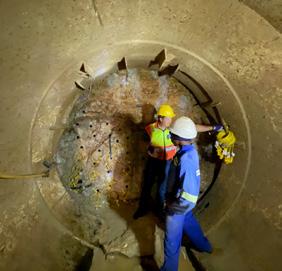

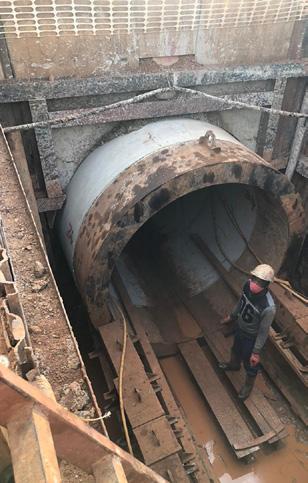 Reinforced concrete pipe sleeves employed on BLOC Contractors’ Rand Water project
Pipe jacking launch pit
Reinforced concrete pipe sleeves employed on BLOC Contractors’ Rand Water project
Pipe jacking launch pit
GEOTECHNICAL
Dinosaur-themed brickwork
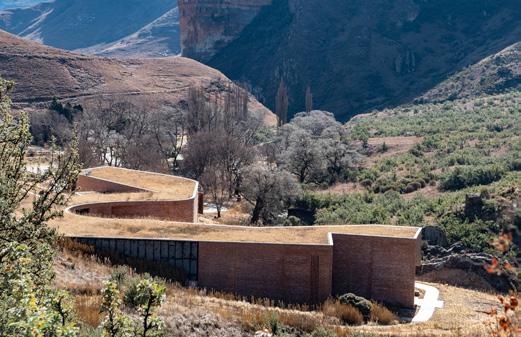
Sharing the ancient past with future generations, the recently constructed Dinosaur Interpretive Centre at the Golden Gate Highlands National Park in Clarens, Free State, has a distinctive design that incorporates dinosaur-themed brickwork in its building elements.
Constructed at a cost of around R83.5 million, the centre will primarily serve as an interactive museum and scientific research station aimed at preserving the remains
of the archaeological site where one of the oldest known dinosaur nesting grounds was discovered in 2012. Internally, the centre will feature an exhibition floor and state-of-the-art laboratories, which make up about 2 500 m2 of floor space.

“The centre is situated at the bottom of a massive sandstone rock outcrop and the face brick used for construction had to be strategically selected to match the colour of the sandstone, with a view to matching and enhancing the beauty and aesthetics of the landscape,” explains Matthew Simmonds, contracts director at GVK-Siya Zama.

Construction of the centre commenced in 2019 and reached practical completion in March this year. GVK-Siya Zama has since been conducting additional work on the interior of the building.


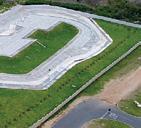


T: +27 (0)21 982 6570 F: +27 (0)21 981 0868 60 Bracken Street, Protea Heights Brackenfell, South Africa, 7560 P O Box 931, Brackenfell, 7561 • Waste Collection Optimisation • Transfer Station Design • Material Recovery Facility Design • General Waste Landfill Design • Hazardous Waste Landfill Design • Landfill Closure and Rehabilitation Design • External Auditing of Waste Facilities • Regional Waste Studies • PPP Involvement in Waste Management • Alternative Technologies for Waste Diversion • Integrated Waste Management Plans • Closure/Rehabilitation Cost Provisions Specialist Waste Management Consultants www.jpce.co.za BUILDINGS
The Dinosaur Interpretive Centre features rooftop vegetation to blend in with the surrounding landscape
The architectural design called for brickwork in patterns that resemble dinosaur scales
MUNICIPAL WASTE COMPLIANCE Investment in mechanisation to boost

To help address the situation, during 2018/19, the Department of Forestry, Fisheries and the Environment (DFFE) engaged with the Department of Cooperative Governance and Traditional Affairs (CoGTA) and National Treasury, requesting that municipalities be permitted to procure waste collection and landfill operation vehicles through the Municipal Infrastructure Grant (MIG). This request was subsequently approved following an amendment to the MIG regulations.
To raise awareness of this development, and as part of its National Waste Management Strategy (NWMS), the DFFE recently used its own resources to fund the provision of 24 pieces of equipment to 20 municipalities nationally – at a cost of around R44.5 million.
The equipment supplied includes skip loader trucks, front-end loaders, compactor trucks and TLBs.
Strategic interventions for waste
The NWMS, which was revised in 2020, aims to provide a framework for government policy and strategic interventions for the waste sector. It is aligned and responsive to the Sustainable
Development Goals (SDGs) of Agenda 2030 adopted by all UN member states.
It is also aligned and responsive to South Africa’s National Development Plan: Vision 2030, which is our country’s specific response to, and integration of, the SDGs within our overall socio-economic development plans.
The strategy is based on the update and revision of the 2011 version and is said to be built on the success and lessons learnt from the previous iteration.
The 2020 version focuses on the introduced concept of a circular economy, aiming to reduce environmental impacts by the reuse and recycling of processed materials. The concept and strategy are further expanded on through the three strategic pillars:
• waste minimisation
• effective and sustainable waste services
• compliance, enforcement and awareness.
The Minister of the DFFE, Barbara Creecy, has reiterated that in order to achieve the goals of this strategy, all stakeholders must play their part. “National and provincial government must support municipalities to develop local integrated waste management strategies. We must ensure our landfills comply with the regulatory environment and waste does not leach into groundwater or into the soil.
Many local municipalities find themselves facing serious challenges in executing waste collection services due to inadequate fleets and equipment that are the result of insufficient budgets.
We must invest in the yellow fleet and, every year, we must ensure more and more homes have access to safe waste disposal,” Creecy explains.
To improve waste management in municipalities, the DFFE is assisting in the development of their integrated waste management plans, and training on sustainable waste management practices.
Public-private collaboration
Creecy asserts that the private sector must also promote the circular economy and divert waste from landfills, seeing as government has already set up the regulatory environment for extended producer responsibility schemes to promote recycling in the packaging, electronics and lighting industries, with recent regulations gazetted for new sectors such as used oil and pesticides.
“Government and the private sector must work with waste reclaimers so that we build a dignified waste reclaiming industry that promotes waste diversion from landfills, promotes the circular economy, and gives a decent livelihood to the tens of thousands of men and women who do the daily, backbreaking work of the recycling industry,” Creecy concludes.
IMIESA August 2022 47
LANDFILL & WASTE MANAGEMENT
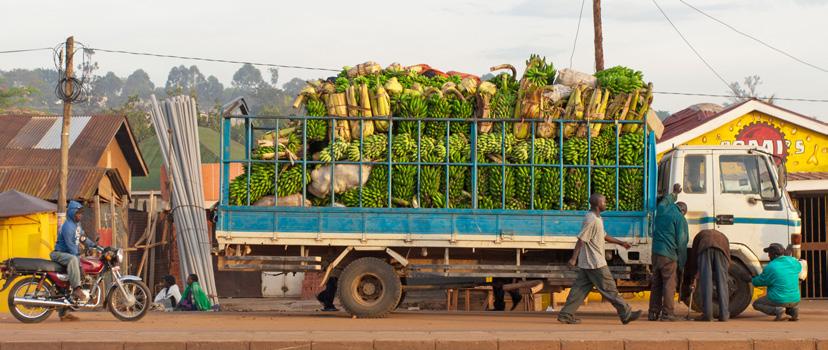
GREEN INTERVENTIONS for Kampala
JG Afrika, alongside RWA Group and Cardno International Development, is helping to map out a world-class integrated waste management (IWM) and diversion strategy for Uganda’s capital city.
JG Afrika, a 100-year-old leading engineering and environmental consultancy, is part of a professional team supporting the Greater Kampala Metropolitan Area (GKMA) towards implementing a robust solid waste management plan for Uganda’s rapidly growing national and commercial capital, as well as neighbouring authorities, as a regional and collective approach.
Richard Emery – technical director and manager: Municipal Infrastructure and IWM at JG Afrika – and the JG Afrika specialist team, which includes organic waste specialist and process engineer Dr Jefrey Pilusa, are working with the greater team deployed on this project. Being among the foremost IWM experts in South Africa, Emery and Pilusa bring extensive technical skills and learning in the design and implementation of IWM projects to this assignment.
The GKMA is facing similar waste management challenges to those experienced in South African cities. “A key difference, however, is that the GKMA has limited technical capacity required to implement its vast academic knowledge and real
understanding of international trends and technologies. This is compared to South Africa’s more engineered-managed systems, which we aim to help GKMA implement to better manage solid waste diversion and systems in the area,” Emery explains.
“The project will also assist GKMA in honouring its commitment to reducing carbon emissions, as articulated in the Kampala Climate Change Action Strategy – a key instrument it uses to help mainstream climate change response in all city services,” Emery continues.
The project is being carried out under the Cities and Infrastructure for Growth programme funded by UKAid and implemented by Cardno International Development, which appointed JG Afrika to provide technical and specialised services, based on the firm’s impressive track record designing and implementing unique IWM solutions and project implementation (design, construction, operation).
Kiteezi landfill strategy
Currently in the concept engineering design phase, the project focuses on diverting solid waste away from the Kiteezi landfill and
allowing businesses and investors to benefit from some of these recovered materials. In the interim, consideration is given towards establishing a methane gas-to-energy plant of at least 2 MW in capacity on-site due to the high organic content of the waste stream.
Kiteezi landfill is situated within Nangabo subcounty in the Wakiso district and is Uganda’s largest and main landfill. About 14.5 ha in size, with its highest end rising up to 10 m, it is partially lined and features a leachate treatment plant that is no longer functioning as it should and as designed.
The capacity of the landfill has been exhausted. Therefore, the local authorities are trying to find a suitable alternative site where large quantities of solid waste generated by the GKMA constituents can be disposed of as an interim solution. This remains a challenge considering limited municipal land available for this purpose.
The GKMA comprises very densified urbanised and low-density rural areas that are highly scattered. Most of the land in the GKMA is in private hands and owners are reluctant to sell it to the municipality at a fair price, more so to use as a landfill site. Meanwhile, as a very short-term measure, small pieces of land are being earmarked by the local authorities to help dispose of well over 28 000 t of waste that is still being sent to the landfill every month. Some of the waste is being disposed of at unauthorised areas, posing severe environmental and health risks to the general public.
Agriculture-based communities
Notably, most of the waste generated in the area consists of organic material, considering the strong agriculture-based communities in the country. Located on the equator, the country
48 IMIESA August 2022 LANDFILL & WASTE MANAGEMENT
Fruits and vegetables are grown on small subsistence plots and sold at the many streetside markets in the Greater Kampala Metro
has a conducive climate and fertile soils that enable fruit and vegetable production for the greater part of the year. For example, bananas, mangoes, citrus, pineapples and tomatoes are grown on small subsistence plots and sold at the many streetside markets in the GKMA.
There are hundreds of informal waste pickers who earn a livelihood collecting papers, containers and plastic at Kiteezi landfill for recycling purposes. The inorganic waste, consisting mainly of paper and plastic, is collected in very large bags that are rolled to collection trucks. This recovered material is then transported to various areas in the GKMA where it is reused.
The waste diversion component of the project will potentially entail finding appropriate ways of using organic resources as opposed to landfilling it. There are a host of potential landfill diversion solutions that still need to be assessed by JG Afrika, RWA and Cardno, ranging from home composting through to larger, community-based or regional projects. As Emery notes, no two IWM projects are alike. They need to be adapted to the environment and the communities that they serve to be successful.
Through this project, Uganda is also attempting to keep pace with the global trend of better managing residual materials. “The landfilling of these materials is harmful to the environment and causes serious health problems. Many countries are, thus, at the cusp of ensuring that all organic waste is diverted from landfills. In South Africa, for example, the Western Cape Provincial Government aims to completely eliminate organic waste from its landfills by 2027. This is a very ambitious target that could be emulated in other areas of the country via novel IWM projects,” he says.
Socio-economic impact of landfill closure
One of the main challenges of the project will be determining how best to manage the potential socio-economic impact that the gradual closure of the Kiteezi landfill site will have on the many informal pickers while organic waste is being diverted. There are numerous scenarios that need to be thoroughly assessed, and they will all require careful and extensive planning before being implemented.

For example, one option is to keep the landfill site open to these communities until materials become too difficult to recover. The informal waste pickers will slowly find other means of sustaining themselves and the landfill can, therefore, be closed without any further socio-economic impact. Another option is to help the affected communities establish small businesses, such as roadside markets and stalls, to sustain themselves as the Kiteezi landfill site is gradually closed.
Project funding
Timelines for the implementation of the IWM project are still uncertain. They are dependent upon the findings of the environmental and social impact assessments, as well as the ability of the GKMA to finance the project, including the proposed development of a methane gas-toenergy plant as a potential project. However, the country has been very successful in attracting private and grant funding for projects, to date. Through
There are hundreds of informal waste pickers who earn a livelihood collecting papers, containers and plastic at Kiteezi landfill for recycling purposes
municipalities, this is also used to fund feasibility studies. The country already has many bankable projects that are attracting further private investors and grant funding. This project is especially enticing considering the significant demand for IWM in the city, with many private participants having already identified an opportunity to become involved in providing essential services on behalf of the GKMA.
The country also needs more renewable energy to help meet its carbon reduction targets and it has a developing electricity distribution grid to support these projects. These are further factors that potential funders may find appealing.
“I remain very impressed with the country, especially its wealth of academic knowledge, which includes an intimate understanding of international trends and technologies. This continues to shine through in my interactions with relevant stakeholders. I believe Uganda is poised for great things,” Emery concludes.

LANDFILL & WASTE MANAGEMENT
An overview of a section of Kampala
ALL THE BELLS AND WHISTLES
for new E-series water tankers
Local OEM Bell Equipment has expanded its range of water tankers and now offers eight tank sizes following the introduction of 16 000 ℓ and 50 000 ℓ offerings.
Warren Swart, product manager, Bell Equipment, represents the company’s custommade machines that are designed and manufactured by its dedicated Bell Application Equipment (BAE) division. This includes the Versatruck programme that comprises derivatives based on the chassis of the acclaimed Bell E-series articulated dump truck (ADT) range, such as water tankers.
According to Swart, one of the primary purposes of a water tanker is dust suppression and the 50 000 ℓ tank was designed following interest from larger mining companies requiring more capacity on longer runways.
“During dry seasons, dust suppression is a critical part of safety in mining and construction operations, from visibility improvements to pulmonary disease prevention. We are also able to offer firefighting options to provide an additional benefit, with one of our customers recommending our 38 000 ℓ water tank for mitigating fire risks in tall structures due to the remote water cannon stream reaching heights above 30 m,” Swart explains.
The 50 000 ℓ tank is paired with the B60E powerhead, making it one of the largest articulated water tankers available on the global market. While it enables Bell to offer a full range of tank sizes, the B60E water tanker importantly offers commonality of parts to the growing number of customers running fleets of B60Es.
16 000 ℓ water tanker development
At the opposite end of the scale, the 16 000 ℓ water tanker was developed
Warren Swart, product manager, Bell Equipment, with a 27 000 ℓ water tank ready for fitment
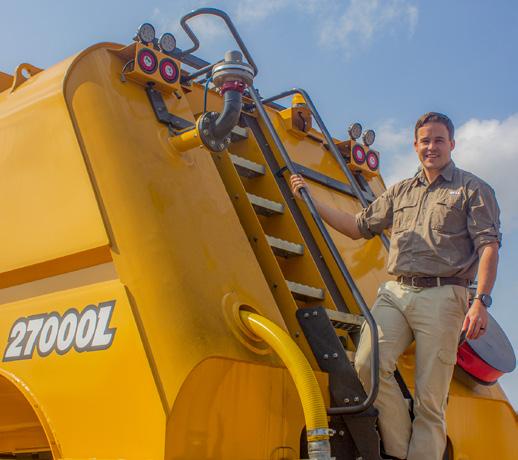
specifically with Bell Equipment’s Australian customers in mind. “Meeting the unique requirement to have a smaller articulated water tanker in tight industrialised areas stands as a testimony to our long-standing skill of listening to our customers’ requirements and innovating solutions to meet these needs,” says Swart.
“The 16 000 ℓ water tank complements the 38 000 ℓ water tank commonly sold into Australia with a top fill chute only, which excludes the standard dam or reservoir filling solution we have available. External plumbing is also kept to a minimum and guard rails are used to increase safety when an operator is required to climb on top of the water tank.”
BAE enables Bell Equipment to give focus to the design and manufacturing of specialised products for individual markets and ensures that quality standards are on par with the rest of the Bell range. With regard to the water tanker design, Swart explains that the centre of gravity is kept low to reduce the risk of rollovers, while a fully engineered baffle system prevents water surge and slosh, providing increased stability for greater
safety. In addition, tanks are coated internally with a dual epoxy paint lining as standard to prolong the life of the tank.
“Most of the truck is built through Bell Equipment’s standard high-quality production facility, while the water tankers, as specialised vehicles, are manufactured on our BAE line. This ensures that we remain cost competitive, while providing the time that our specialised vehicles require to meet our world-class quality standards. We adhere to international welding quality standards for earthmoving and construction equipment (AWD D14.3), with the inclusion of additional Bell-specific quality inspection processes, such as a pressurised leak test on all tanks produced,” Swart adds.
Water cannon and spray configurations
“Our water tanks can be customised to meet the customer’s requirements with a wide range of options. To mention a few, we offer a manual water cannon with a long-range spray nozzle and a remote water cannon that is remotely controlled using a joystick inside
50 IMIESA August 2022
Our water tanks are engineered to perfectly integrate with our E-series ADTs as a complete unit.”
Bell powerhouse pairings for the company’s range of water tanks:
16 000 ℓ Bell 2304E / Bell 2806E
18 000 ℓ B18E
23 000 ℓ B25E
23 000 ℓ B30E
27 000 ℓ B40E
35 000 ℓ B45E
38 000 ℓ B50E
50 000 ℓ B60E
the cab. This cannon has an adjustable fog/ stream pattern and a variety of flow settings between 1 100 and 3 200 litres per minute. Both water cannons feature high-quality components, making them highly suitable for heavy-duty applications,” explains Swart.
Other options include additional battery spray valves that expand the spray pattern horizontally. Additionally, a range of rear spray bars are available, beginning with a gravity-fed dribble bar that delivers an even spread pattern covering the width of the vehicle. Penetration spray bars are also available, with either nozzles or holes, and are pressurised by the pump to create a jet of water that is not affected by wind.
These options are complemented with the design of an in-cab control panel for all water tank functions. This provides an ergonomically sound control environment for the operator inside the cab. The in-cab control panel increases productivity and ensures operations are never interrupted by the need to exit the cab and manually open external valves.
Perhaps the most important feature is that since Bell, as an OEM, builds both the main chassis and the additional component required by the customer – in this case, the water tank – the finished product enjoys full factory support. This means that wherever in the world a customer takes a Bell Versatruck solution, they can be guaranteed of Bell Equipment’s technical support offered through the company’s global network of customer service centres and dealers.


VEHICLES & EQUIPMENT
Note: The B25E and B30E are also available with a diesel bowser option, with plans to expand this range to match the current water tank series.
Tankers can be fitted with a manual water cannon with a long-range spray nozzle, or one that’s remotely controlled via a joystick inside the cab
Bell Equipment’s 16 000 ℓ water tank
COMPACTION INNOVATION on show at bauma
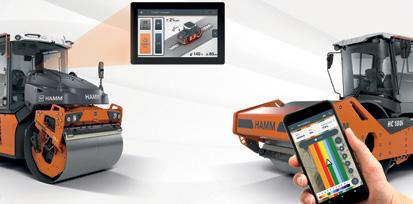
With the latest-generation HC series, Hamm is bringing together all compactors with an operating weight of 11 t to 25 t on a single platform. Research and development (R&D) upgrades include an up to 15% increase in centrifugal force, as well as improved efficiencies thanks to an integrated ECO mode, with options that include automatic engine stop.
Going forward, Hamm’s small compactor segment (5 t to 7 t) will be represented by the HC CompactLine series. In addition to improved driving comfort, Hamm’s R&D team have increased the traction and gradeability.
The groundbreaking HX series
The HX series is the new flagship from Hamm for asphalt construction. These pivot-steered tandem rollers (7 t or 9 t) are following in the footsteps of the DV+ series and are designed for high-quality production. There are models with split and non-split vibration and oscillation drums, as well as combination rollers.
A key component of the well-conceived compaction technology is the integrated
automatic reverse function, which brakes and accelerates the rollers quickly, but smoothly. The electrically adjustable seat operating unit, which automatically turns to the direction of travel when reversing, is also a unique feature.
Eight tandem rollers with electric drive
Unveiled for the first time at bauma 2022 are Hamm’s eight electrified tandem rollers in the HD CompactLine series. Their operation and compaction parameters are identical to the corresponding diesel-driven machines, with the key difference that they are completely battery-powered. Significantly, these rollers can work for an entire workday on a single charge. These models also include the world’s first electric combination roller with oscillation.
Tyre heating with diesel instead of gas
Another innovation showcased at bauma is Hamm’s improved heating solution for its pneumatic tyre rollers, which does away with the need for gas. The new burner is fed with diesel from the fuel tank, efficiently
preventing asphalt from adhering to the tyres during compaction.
Smart Doc and Smart Compact
To optimise overall results, Hamm has also invested in digital technologies, which include the Smart Doc app. The latter displays, in real time, how the compaction develops and links the machine data to GNSS position data. The app uses this data to create compaction reports in PDF format and is therefore also suitable for self-monitoring.
An allied development is Hamm’s Smart Compact compaction assistant, which raises the quality of the compaction to a new level by integrating local weather data into the evaluation. In addition to the physical properties of the asphalt, the system also evaluates its complex cooling behaviour. Using this, it continuously determines the optimal setting for each drum separately –i.e. whether compaction is carried out with vibration, with big or small amplitude, with oscillation or statically.
As an added benefit, Smart Compact can determine when to move the roller into ECO mode and therefore save fuel.

52 IMIESA August 2022
VEHICLES & EQUIPMENT
Hamm’s new Smart Doc and Smart Compact digital tools take compaction performance to a new level
At bauma 2022, Hamm will showcase latest-generation series updates as well as new models that include electrically powered compact rollers
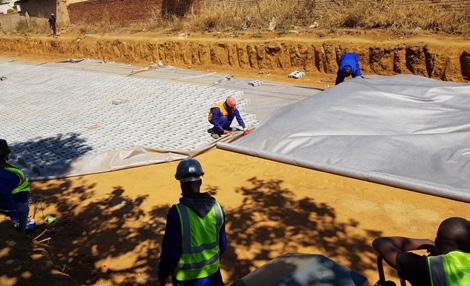
The Armorflex Erosion Control System 140 was selected for upgrades to major stormwater systems in Mamelodi Ext 4 and 5 north-east of Pretoria.
recognised at CMA Awards ROCLA AND TECHNICRETE
A section of Rocla HDPE lined precast piping installed for the Polokwane Wastewater Treatment Project
Competing against the best, Rocla and Technicrete were honoured with Engineering Excellence Awards in the Infrastructure and Paving categories at the Concrete Manufacturers Association (CMA) 2022 Digital Awards for Excellence.
“The CMA’s recognition adds value to the entire Rocla and Technicrete teams’ efforts to deliver a superior solution,” says Malebusa Sebatane, group manager: Marketing and Communications for the ISG Group, which owns the Rocla and Technicrete brands.
Rocla, winner of the Infrastructure category, supplied over 19 km of HDPE lined precast piping to Safcrete Construction for the

Polokwane Wastewater Treatment Project. The latter was commissioned by Polokwane Municipality to upgrade an outdated sewerage system servicing the Seshego area. The precast concrete pipes supplied measured 1 980 mm x 1 000 mm and 2 116 mm x 900 mm. The placement of each pipe also required the insertion of a rubber ring and the welding of a ‘capping strip’ on the inside of each individual joint to ensure a proper seal.
Amorflex
Announced as the winner of the Paving category, Technicrete’s internationally
licensed Armorflex Erosion Control System 140 was selected for upgrades to major stormwater systems in Mamelodi Ext 4 and 5 north-east of Pretoria. Tefla, who undertook the project, said Armorflex’s easy installation enabled the company to outsource 30% of the work to the local community, facilitating a skills transfer element in the project.
Based on a trapezoidal channel analysis of water volumes and velocity, Armorflex 140 was selected as the best system to install for the gradual channel to be constructed.


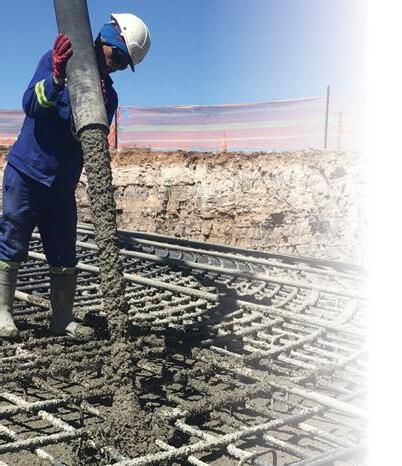


TECHNOLOGICAL INNOVATION IN THE CONCRETE INDUSTRY STARTS WITH MAP PRODUCTS.

• Precast concrete plasticising admixtures
• Ready-mixed concrete plasticising admixtures
• Extended workability polymers
• Set retarding admixtures
• Hardening accelerators
• Viscosity modifying admixtures
• Form release agents
• Synthetic fibres
• Pozzolan-activity mineral additions
• Permeability-reducing admixtures
• Water-repelling admixtures
• Anti-washout admixtures
• Expanding agents
• Drying shrinkage-reducing admixtures
• Clay mitigating admixtures
• Pumping aides
• Air entraining and foaming agents
• Concrete rescue packs
• Evaporation-retarding admixtures
Learn more at mapei.co.za Tel: +27 11 552 8476 Email: info@mapei.co.za
CEMENT & CONCRETE

IMESA AFFILIATE MEMBERS
PROFESSIONAL AFFILIATES



























































































MESA IMESA
AECOM
siphokuhle.dlamini@aecom.com
AFI Consult banie@afri-infra.com
Alake Consulting Engineers lunga@alakeconsulting.com
ARRB Systems info@arrbsystemssa.com
Asla Construction (Pty) Ltd johanv@asla.co.za
BMK Group brian@bmkgroup.co.za
Bosch Projects (Pty) Ltd mail@boschprojects.co.za
BVI Consulting Engineers marketing@bviho.co.za
CCG puhumudzo@ccgsytems.co.za / info@ccgsystems.co.za
Corrosion Institute of Southern Africa secretary@corrosioninstitute.org.za
Dlamindlovu Consulting Engineers & Project Managers info@dlami-ndlovu.co.za
EFG Engineers eric@efgeng.co.za
Elster Kent Metering Mark.Shamley@Honeywell.com
EMS Solutions paul@emssolutions.co.za
ERWAT mail@erwat.co.za
GIBB marketing@gibb.co.za
GIGSA secretary@gigsa.org
GLS Consulting nicky@gls.co.za
Gorman Rupp Cordeiro@gormanrupp.co.za
Gudunkomo Investments & Consulting info@gudunkomo.co.za
Hatch Africa (Pty) Ltd info@hatch.co.za
HB Glass Filter Media info@hardybulkinglass.com
Herrenknecht schiewe.helene@herrenknecht.de Huber Technology cs@hubersa.com
Hydro-comp Enterprises info@edams.co.za
Infrachamps Consulting info@infrachamps.co.za
INFRATEC info@infratec.co.za
IQHINA Consulting Engineers & Project Managers info@iqhina.co.za iX engineers (Pty) Ltd hans.k@ixengineers.co.za
JBFE Consulting (Pty) Ltd issie@jbfe.co.za
JG Afrika DennyC@jgafrika.com
KABE Consulting Engineers info@kabe.co.za
Kago Consulting Engineers kagocon@kago.co.za
Kantey & Templer (K&T) Consulting Engineers ccherry@ct.kanteys.co.za
Kitso Botlhale Consulting Engineers info@kitsobce.co.za
KSB Pumps and Valves (Pty) Ltd salesza@ksb.com
KUREMA Engineering (Pty) Ltd info@kurema.co.za
Lektratek Water general@lwt.co.za
Makhaotse Narasimulu & Associates mmakhaotse@mna-sa.co.za
Mariswe (Pty) Ltd neshniec@mariswe.com
Martin & East gbyron@martin-east.co.za
M & C Consulting Engineers (Pty) Ltd info@mcconsulting.co.za
Mhiduve adminpotch@mhiduve.co.za
MPAMOT (PTY) LTD mpumem@mpamot.com
Mvubu Consulting & Project Managers miranda@mvubu.net
Nyeleti Consulting naidoot@nyeleti.co.za
Odour Engineering Systems mathewc@oes.co.za
Prociv Consulting & Projects Management amarunga@prociv.co.za
Rainbow Reservoirs quin@rainbowres.com
Re-Solve Consulting (Pty) Ltd maura@re-solve.co.za
Ribicon Consulting Group (Pty) Ltd info@ribicon.co.za
Royal HaskoningDHV francisg@rhdv.com
SABITA info@sabita.co.za
SAFRIPOL mberry@safripol.com
SAGI annette@sagi.co.za
SALGA info@salga.org.za
SAPPMA admin@sappma.co.za / willem@sappma.co.za
SARF administrator@sarf.org.za.co.za
SBS Water Systems marketing@sbstanks.co.za
Silulumanzi Antoinette.Diphoko@silulumanzi.com
SiVEST SA info@sivest.co.za
Sizabantu Piping Systems (Pty) Ltd gregl@sizabantupipingsystems.com
Siza Water (RF) Pty Ltd PA@sizawater.com
Sky High Consulting Engineers (Pty) Ltd info@shconsultong.co.za
SKYV Consulting Engineers (Pty) Ltd kamesh@skyv.co.za
Smartlock jp.alkema@smartlock.net
SMEC capetown@smec.com
Southern African Society for Trenchless Technology director@sasst.org.za
SRK Consulting jomar@srk.co.za
Star Of Life Emergency Trading CC admin@staroflife.co.za
TPA Consulting roger@tpa.co.za
V3 Consulting Engineers (Pty) Ltd info@v3consulting.co.za
VIP Consulting Engineers esme@vipconsulting.co.za
VNA info@vnac.co.za
Water Institute of Southern Africa wisa@wisa.org.za
Wam Technology CC support@wamsys.co.za
Wilo South Africa marketingsa@wilo.co.za
WRCON ben@wrcon.co.za
WRP ronniem@wrp.co.za
Zutari Rashree.Maharaj@Zutari.com
A section of the concrete forming part of the new wastewater treatment works

WATERTIGHT SOLUTIONS for new treatment works
To keep pace with population growth, a new wastewater treatment plant was recently constructed in the Northern Cape town of Orania, which now has four times the processing power of the old works. Orania Infrastruktuur was the appointed contractor on the project, which ran from March through to mid-December 2021.
Sika SA was consulted, asked to consider solutions, and then supplied the relevant specified materials to the project. It was important to ensure that the concrete works and joints be totally watertight. The basic methodology initially required the installation and fastening of Sika-Waterbar DR EG, an expansion joint sealant for watertight concrete construction, prior to casting of the concrete.
SikaPlast 220VX, a water-reducing multipurpose admixture was dosed at the readymix supplier, and Sika WT-200 P was then added to the load just prior to discharge, and thoroughly mixed. Sika WT-200 P is a combined water-resisting and crystalline waterproofing admixture used to reduce the permeability of concrete and to enhance the selfhealing abilities of the concrete.
SikaPlast-220 VX can be used in both readymix and on-site batching applications, and is ideal for use with lean, harsh concrete mixes, and concrete containing slag, fly ash or microsilica. Additionally, SikaPlast-220 VX’s superplasticising action provides high-slump, flowing concrete that maintains excellent workability and may be placed with minimal vibration.
Application criteria
The selection of a suitable Sika-Waterbar is governed by the type of joint, the concrete thickness, grade of concrete, reinforcement position, expected movement (expansion/shear), as well as the water head to which it is to be exposed. The correct consistency of the concrete itself is also important, and the aggregates must be well graded.
The Sika-Waterbar DR EG range is made from thermoplastic PVC and can therefore be easily heat welded – as adhesive jointing is not permitted. Further advantages include high tensile strength and elongation, permanent flexibility, resistance to hydrostatic pressure/ stress, and a resistance to natural soil and groundwater mediums – all important factors in ensuring a watertight structure.
IMIESA August 2022 55
CEMENT & CONCRETE
Economical foamed concrete SUITABLE FOR LIMITED BUDGETS
Foamed concrete is the most popular of all low-density concretes in developing countries, mainly because of its low capital expenditure on equipment and the ready availability of its principal materials, says Bryan Perrie, CEO of Cement & Concrete South Africa (CCSA).
oamed concrete can be produced on a small scale, even at site level, and is relatively easy to place and finish without heavy or expensive equipment. It has been used as a structural material in schools, apartments and housing developments in countries such as Brazil, Singapore, Kuwait, Nigeria, Botswana, Mexico, Indonesia, Libya, Saudi Arabia, Algeria, Iraq and Egypt,” Perrie states.
Foamed concrete is a cementitious material, with a minimum of 20% (per volume) foam entrained into the plastic mortar but, as no coarse aggregate is used, the term ‘concrete’ is basically inappropriate, he explains. It is produced by entrapping numerous small bubbles of air in cement paste or mortar.
Mechanical foaming
Mechanical foaming can take place in two principal ways:
• by pre-foaming a suitable foaming agent with water and then combining the foam with the paste or mortar
• by adding a quantity of foaming agent to the slurry and whisking the mixture into a stable mass with the required density. Perrie says the most commonly used foam


concentrates are based on protein hydrolyzates or synthetic surfactants. These are formulated to produce air bubbles that are stable enough to resist the physical and chemical forces imposed during mixing, placing and hardening. Foamed concrete is self-compacting, freeflowing and pumpable, and therefore easy to place in inaccessible places. It has good thermal and acoustic properties and is frost resistant. It is, however, too weak for direct exposure to traffic and hail, and should be protected by a wearing layer.
Dry density
“It is standard practice to classify foamed concrete according to its dry density. The density is determined from oven-dried specimens, and the actual density of foamed concrete would usually be higher than this density, as there would generally be evaporable water present in foamed concrete.
The presence of water in foamed concrete elements also results in an increase in thermal conductivity,” Perrie explains.
Since the introduction of cellular concrete systems to the construction industry almost six decades ago, its use has almost exclusively been limited to non-structural void filling,
thermal insulation, acoustic damping, trench filling for reinstatement of roads and for building blocks. In the Netherlands, foamed concrete has been used not only for level corrections in housing developments, but also as a fill material where ground subsidence has taken place and as a founding layer for road works on very weak soils.
“Historically, foamed concrete has been perceived to be weak and non-durable with high shrinkage characteristics. Unstable foams have in the past resulted in foamed concrete not being suitable for reinforced, structural applications. However, the development of protein hydrolisation based foaming agents and specialised foam generating equipment has improved the stability of the foam, making it possible to manufacture foamed concrete for structural applications,” adds Perrie.
“But it is important to ensure that the air entrained into the foamed concrete is contained in stable bubbles that remain intact and isolated to ensure that the permeability of the cement paste between the voids is not increased,” Perrie concludes.
www.cemcon-sa.org.za
APE Pumps 15 AfriSam South Africa 40 ARRB Systems 32 Bell Equipment Group Services 28 CIDB ERWIC Awards 22 EnviroServ Waste Management IBC Gabion Baskets 11 Hydrogen-Africa 21 IMESA 4, 16 & 54 JPCE 46 Keller Nederland 2 Kenzam Equipment 30 Mapei South Africa 53 MDCC OBC Much Asphalt OFC Rocla 39 Sabita 29 SAPPMA 27 Sizabantu Piping Systems IFC SMEC South Africa 19 Strategic Business Services 24 VEGA Controls SA 8 INDEX TO ADVERTISERS 56 IMIESA August 2022
F
CEMENT & CONCRETE
Bryan Perrie, CEO, Cement & Concrete South Africa






From waste to resource
With over 40 years’ experience in the waste management industry, collaboration with customers is how we drive the circular economy.
We implement agile and innovative waste solutions, proudly ensuring environmental peace of mind through our commitment to industry standards.
TODAY’S WASTE IS TOMORROW’S RESOURCE FIND OUT MORE 27 588
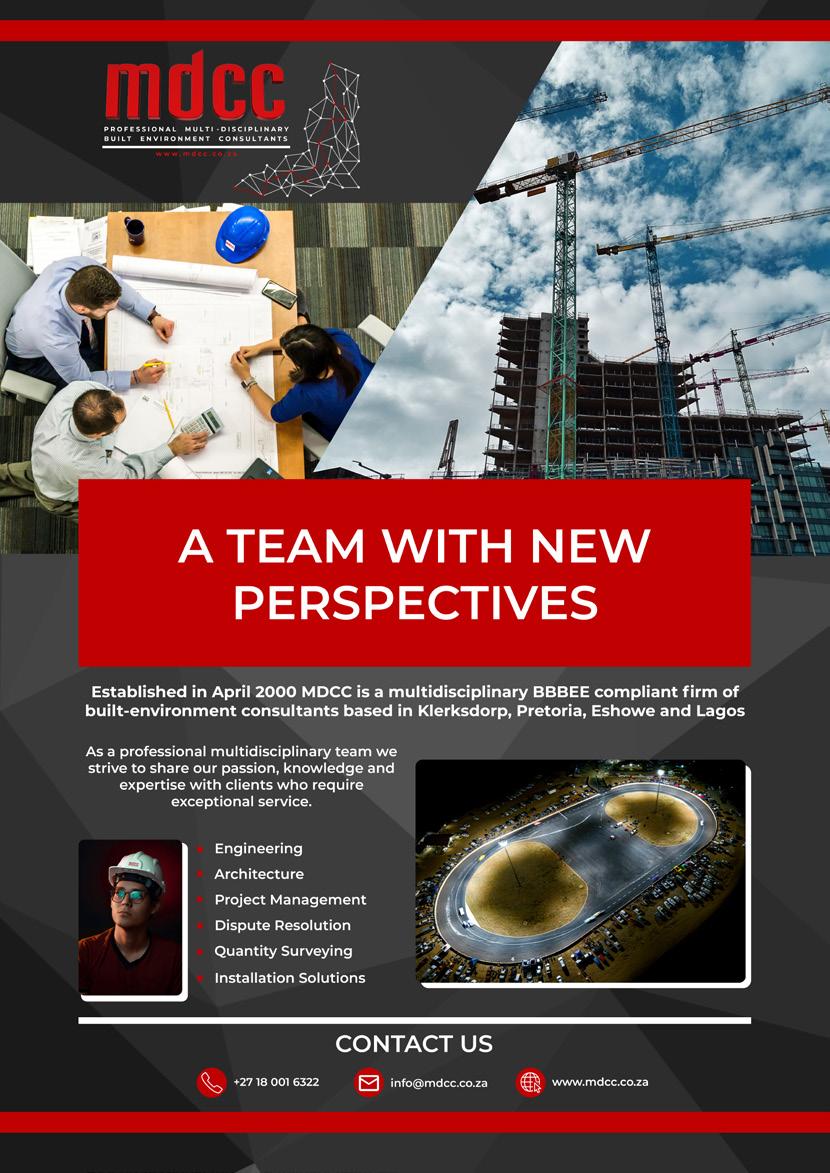




































































































































































































































































































































































































































































 Segregation of G1 patching material creating a permeable joint
An example of well-intended, but poorly executed, pothole patching. Key errors to note are the incorrect choice of base material, as well as poor joint placement
Segregation of G1 patching material creating a permeable joint
An example of well-intended, but poorly executed, pothole patching. Key errors to note are the incorrect choice of base material, as well as poor joint placement



























 Reinforced concrete pipe sleeves employed on BLOC Contractors’ Rand Water project
Pipe jacking launch pit
Reinforced concrete pipe sleeves employed on BLOC Contractors’ Rand Water project
Pipe jacking launch pit



























































